

| Trade log-in: | HERE | |
| Get password | Forgot password | ||

2015.3 | 2015.2 | 2015.1
2014.3 | 2014.2 | 2014.1 | 2013.3 | 2013.2 | 2013.1 | 2012.3 | 2012.2 | 2012.1
2011.3 | 2011.2 | 2011.1 | 2010.3 | 2010.2 | 2010.1 | 2009.3 | 2009.2 | 2009.1
2008.3 | 2008.2 | 2008.1 | 2007.3 | 2007.2 | 2007.1 | 2006.3 | 2006.2 | 2006.1
2005 | 2004 | 2003 | 2002 | 2001 | 2000
In this edition of our newsletter we are honored to present Part One of an unfinished manuscript by the legendary Martin Ehrmann, “The Ruby Mines of Mogok.” And, as always, there’s a lot more to catch the eye…
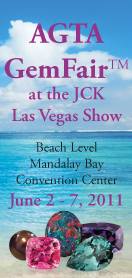 |
It’s time to plan for the JCK Las Vegas show. Pala International will be there in force, with one of America’s largest selections of fine colored gems.
Note: The JCK Show this year again runs Friday through Tuesday. The AGTA Pavilion still opens one day early—Thursday, June 2—before the main JCK Show.
When: June 2–7, 2011
Where: South Pacific and Islander Ballrooms in the Mandalay Bay Convention Center, Las Vegas, NV
Hours: AGTA Gemstone Section
Thursday, June 2 thru Monday, June 6:
9:30 AM – 6:00 PM
Tuesday, June 7: 9:30 AM – 4:00 PM
Booth: AGTA Pavilion, booth AGTA514
See also this notice from AGTA about the GemFair. We look forward to seeing our many friends there. Visit the Pala International Show Schedule for future events. [back to top]
The first Santa Barbara Jade and Ocean Arts Festival will take place in mid-May at Chase Palm Park on the Pacific Ocean. Ocean-themed artwork from a variety disciplines will be offered at the festival. And, of course, jade.
Among the several artists who work in jade will be featured Donn Salt, whose carved nephrite pendant accompanied our Christchurch earthquake appeal last month. Also on hand will be Georg Schmerholz, who told us in a charming conversation yesterday that, relatively speaking, he’s actually new to the medium of jade. As a sculptor for many years, he worked with jade only occasionally. It is in the last few years has he, as he puts it on his website, “immersed myself completely in the beauty of Jade, and become inspired and fully committed.”
One of the concepts from which he receives his inspiration, Schmerholz told us, is shibumi, the Japanese notion that novelist Trevanian described as “great refinement underlying commonplace appearances.” As Schmerholz told us of his decades-long, patient path to jade, other words of Trevanian come to mind: “One must pass through knowledge and arrive at simplicity, to arrive at shibumi.”
Take, for instance, the sculptor’s Heart2Heart. From one angle, it’s a double-chambered cardioid-mirroring of jade and bronze. But it reveals itself to be anything but muscular; it is lily-like. A closer look exposes flaws in the jade—veins and feathers: a resting bird’s wing. As the artist explains, “a piece of jade that was less than perfect became the focus of the creative process.” Singer-songwriter Leonard Cohen, no stranger to Japanese thought, put it this way, in “Anthem”:
Forget your perfect offering
There is a crack in everything
That’s how the light gets in.
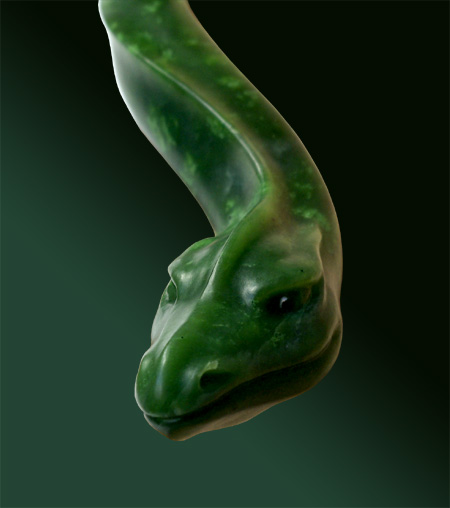 |
| Georg Schmerholz pored over several hundred dollars worth of books on the lore of dragons before conceiving his Baby Draco. Above, a detail of the serpent, who slithers in three other views on the artist’s website. (Photo: Georg Schmerholz) |
To his jewelry rendered in jade, Schmerholz brings a sculptor’s sensibility, as can be seen by his Baby Draco torque: Gaulish in form, mythical in mien—and Transylvanian? “In this lifetime I was born Hungarian in Transylvania,” explains the artist. [back to top]
This month we feature something a little out of the ordinary—a local Californian/Mexican treat. Pala has found a new supplier of these ocean jewels and it has been exciting to see all the freeform shapes and iridescent colors nature can conjure up. Greens, blues, pinks, purples—oh my! These colorful metallic looking concretions spark in the viewer a wonder of formation and inspire design, as many shapes are personified or reminiscent of earthly objects. For instance, the featured piece below takes on the form of a hot air balloon or a tropical sea creature.
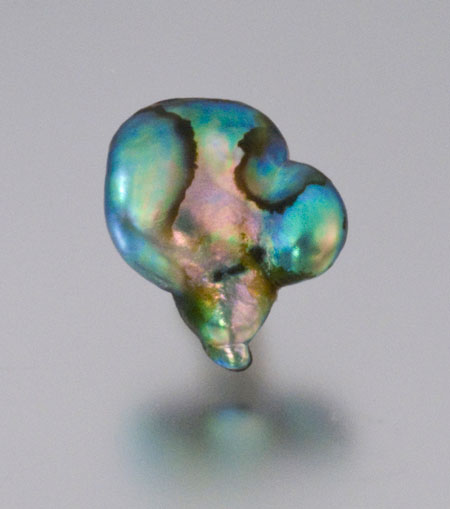 |
| Water balloon. This 11.82-carat freeform natural abalone pearl measures 20 x 17 x 7 mm. (Photo: Jason Stephenson) |
Abalone shells were once completely legal to pry from the ocean floor. For divers, all it took was some scuba gear, some hardware, and a shark radar. Today most of these abalone species are becoming endangered and many restrictions apply on fishing. Fortunately most of the abalone taken from the sea are harvested legally, but an estimated 12% are poached illegally. Natural abalone are estimated to produce a pearl only in one out of 50,000 cases, and it can take as long as eight to ten years to form a pearl. Farm raised abalone can produce a pearl in a shorter, two-to-three-year period.
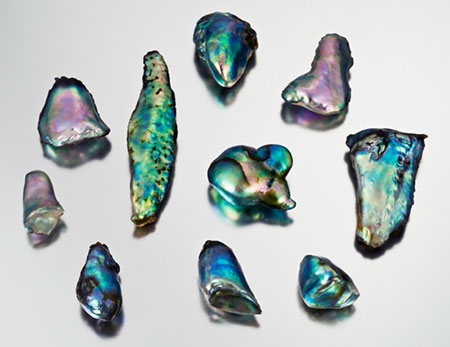 |
| Watercolors. This group of natural abalone pearls shows the variety of sizes, shapes and colors available. Prices for all available upon request. (Photo: Mia Dixon) |
See this government website for current information on abalone. For more on natural pearls see this article by Elise Skalwold from our January edition.
Interested? Call (telephone numbers below), or email us to inquire. [back to top]
GIA (Gemological Institute of America) Laboratory, Bangkok: “An Imitation ‘Melo Pearl’” takes the reader through the steps of identifying a 52.49-carat “pearl.” Employed in the process are visual examination, obtaining specific gravity, microradiography, ultraviolet lighting, and three spectrometry tools. Large images provide useful illustration. If you subscribe to GIA’s G&G eBrief, you’ll want to see “Non-nacreous Pearl Imitation” in the March edition.
Speaking of G&G & simulants… GIA’s Gems & Gemology, Winter 2010, contains “Synthetic Gem Materials in the 2000s: A Decade in Review.”
The same issue of G&G includes “A Study of the Gems in a Ciborium from Einsiedeln Abbey,” in northeastern Switzerland. Various nondestructive techniques were used to examine its 17 colored stones—ten almandine garnets, four grossular garnets, and three sapphires. The ciborium’s historic description and the sapphires’ inclusions suggest the stones’ origin to be Sri Lanka.
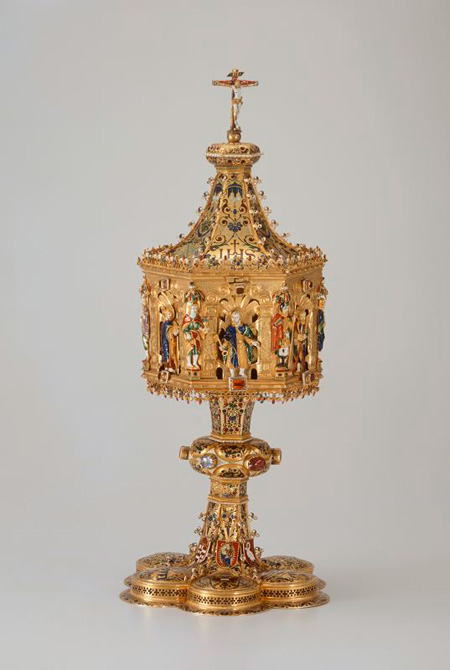 |
| This late-16th-centuray ciborium is from Einsiedeln Abbey, the destination of pilgrims for twelve centuries, now numbering in the hundreds of thousands yearly. This bejeweled eucharistic vessel was loaned to the Swiss National Museum for identification of its materials. (© Kloster Einsiedeln. Photo: Swiss National Museum / Donat Stuppan) |
Lucerne’s Gübelin Gem Lab (which has a nicely revamped website) participated in the above study, and also contributed the featured item to G&G’s regular Gem News International section, a study of one of the lesser known in a baker’s dozen of tourmaline group members. “‘Neon’ Blue-to-Green Cu- and Mn-Bearing Liddicoatite Tourmaline” is the first study of such stones, which are strikingly “similar in hue, tone, and saturation to Paraíba-type tourmaline.” They may have come from Mozambique, near the mine that produced last June’s featured stones from Pala International. That could be welcome news, because the latter gem material is virtually played out.
And more from the Swiss… Basel’s SSEF Swiss Gemmological Institute (also with a redesigned website) has posted Dr. Krzemnicki’s “Fancy Coloured Sapphires: The Beauty beyond ‘Blue’ of Sapphire and ‘Red’ of Ruby,” which provides a very visual overview of the subject.
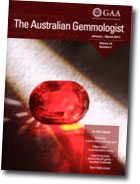 |
The man for whom the mysteries behind phenomenal gems are a passion, Dr. Karl Schmetzer (author of Russian Alexandrites, a review of which we missed earlier, by Richard W. Wise) and his coauthor Dr. Eric Erel (of Carat Gem Lab) take a look at a more obscure, though no less fascinating color-change gemstone in the current Australian Gemmologist: Brazilian triphylite. The samples examined also displayed distinctive pleochroism.
The gemstone on the journal’s cover, shown at right, is a 10.91-carat step cut rhodonite, thought to be the largest faceted stone from Broken Hill, New South Wales, Australia. It is housed in the Royal Ontario Museum (ROM) at Toronto, which in 2007 unveiled the Michael Lee-Chin Crystal—not a jewel, but rather an architectural addition to the museum inspired by the ROM’s gem and mineral collection, and executed by world-class architect Daniel Libeskind. [back to top]
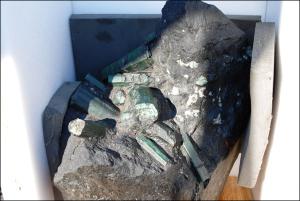 |
Last Friday, Los Angeles Superior Court Judge John A. Kronstadt issued a preliminary ruling, subject to finalization, that Anthony Thomas never purchased the “Bahia” Emerald, according to an April 11 news release issued by law firms involved. “Respondents Kit Morrison, Todd Armstrong, Jerry Ferrara, and FM Holdings, Inc.,” the release stated, “successfully argued that Mr. Thomas’s claim of title of the Bahia Emerald was not credible and should be barred as a matter of law.”
For details on Thomas’s testimony regarding his claim, see our coverage from last November. [back to top]
 |
| Want to convert some cash? This Brazilian alexandrite is just the ticket. See more on Brazilian color-change above. (Photo: Wimon Manorotkul) |
Political unrest in southwest Asia is inflating the price of fine gemstones, according to a March 12 story by Agence France-Presse (AFP). Conversion of wealth into portable property is the strategy.
The Rapaport News Service the previous day stated in its Weekly Market Comment:
Hong Kong show exceeds expectations with very strong buying activity. Show indicated a shift to seller’s market as shortages and increasing Indian and Far East demand enabled higher prices. Investment demand building as Mid-East political instability increases demand for large fine quality D-IF and other high quality investment diamonds. De Beers reports unprecedented rough demand at Feb. Diamdel online auctions. DTC launches sightholder application process for 2012–2015 contract period.
“It’s like an insurance policy,” Martin Rapaport told AFP, “plus it appreciates.” [back to top]
Last month, we pointed to the creativity of NZ gem and jewelry appraisers who were donating a day’s fees to the Red Cross, and holding “Valuation Saturdays”—à la Antiques Road Show—with all appraisal proceeds from the events benefiting the cause.
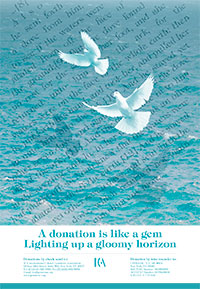 |
Soon after our newsletter was released, an urgent call was emailed to Ambassadors of the ICA (International Colored Gemstone Association) around the globe, asking volunteers to open their homes to at-risk Japanese families in order to escape radiation effects. This was followed shortly by an email forwarded by a second writer who two days before had made a similar, private appeal to his own circle. “You know me personally as a friend,” the writer had told them. “Therefore I am not afraid to raise this crazy idea with you.” In the end, after consultation with contacts in Japan, the effort was deemed “deeply touching” but premature. The gesture, however, shows the lengths to which the gemstone community was willing to go. (Indeed, several responses were received to the initial email, offering to host multiple families until the crisis abates.)
Recently, ICA issued a separate call for donations.
ICA has decided to open a donation channel and let all of us who would like to help – donate a sum of money that will be collected by ICA Head Office and donated on behalf of ICA by the ICA Board of Directors.
The decision on which charities and countries will receive the donations will be taken during ICA General Assembly at the ICA Congress in Rio de Janeiro.
The downloadable poster shown above has details on exactly how checks and wire transfers can be facilitated.
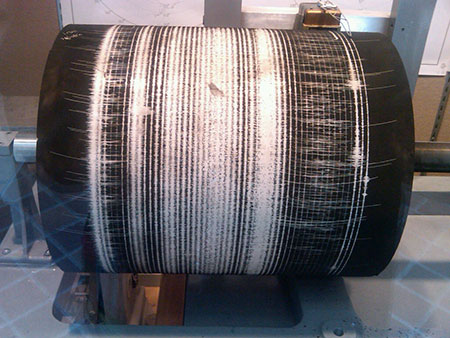 |
| Rocking and rolling. The smoked paper on one of several seismometers housed at Cornell’s Earth and Atmospheric Sciences Department captured a 30-day snapshot of a restless planet. On the left, the earth violently shakes in Christchurch, and on the right, the devastating quake in Japan nearly tears up the drum. Ironically, between the two events, the department's guest seminar series included several noted earthquake specialists, including Roger Bilham; see CIRES and NOVA. (Photo: Elise Skalwold) |
[back to top]
 |
| Natural Burma star sapphire, 17.66 carats, from our Old Stock… New Pix, courtesy Pala photographer Mia Dixon |
The 48th Myanma Gems Emporium, held March 10–22, exceeded €2 billion ($2.8 billion), according to an early April story in the online weekly The Myanmar Times. The sale essentially matches the grand total of last year’s three sales ($2.821 billion).
Out of nearly 17,000 jade lots on offer, 13,608 were sold. About half of the 8,700 buyers in attendance were foreigners. Only 30 out of 206 gem lots were sold.
A Myanmar Pearl Enterprises rep expressed satisfaction after 253 of 285 pearl lots also sold—23 more than at the last sale, in November.
On the night of March 24, a 7.0-magnitude earthquake hit, about 80 kilometers southeast of Mong Hkak (see Hughes, Ruby & Sapphire, p. 336), in the town of Loimwe. The quake killed dozens of people; more than 200 houses were destroyed, as well as 11 monasteries and nine government buildings, according to Xinhua News Service, which also reported on a minor cholera outbreak. Other stories:
 |
| The above image comes from The Best Friend, members of which felt the March 24 earthquake in their location in Chiang Mai, Thailand. They have begun a Shan State Earthquake Relief Project. |
[back to top]
In his introduction to “The Ruby Mines of Mogok,” Pala International’s Bill Larson calls its author, the late Martin Ehrmann, “perhaps the preeminent mineral and gemstone dealer of the 20th century.” The sentiment is echoed by The Mineralogical Record, which regards Ehrmann as “America’s premier dealer in high-quality mineral specimens.”
In January, Bill Larson was contacted by Ehrmann’s son Herb Ehrmann, and after a hook-up in Tucson, Herb and his wife Connie visited Pala’s office in Fallbrook, bearing a gift: the elder Ehrmann’s unpublished manuscript, “The Ruby Mines of Mogok,” complete with a box of color slides.
 |
Pala is honored to have been given permission to present Martin Ehrmann’s unfinished jewel, a story of unbridled curiosity, chutzpah, and charm. We begin with Chapter One. The remaining chapters will be featured in five more monthly installments. [back to top]
The Bowers Museum is exhibiting a body of Harold Van Pelt’s work, which showcases his great skill of gem and mineral carvings. It will run until May 1, 2011. Harold and his wife Erica are known throughout the world for their photography of fine gemstones and mineral specimens. Pala International’s own in-house photographer, Mia Dixon, looks at the exhibition catalog.
 |
Gemstone Carvings: Masterworks by Harold Van Pelt begins with an historical look at gemstone carving, which for the most part is passed on through generations of families, along with a formal education and an apprenticeship. Harold Van Pelt, however, started his carvings as a hobbyist—with no formal training. The book continues with a determination of where his skill and artistry come from:
We still do not know, but there are a few factors we can state with some degree of confidence. First, artistic sense—what might be called an artist’s eye. As highly accomplished professional photographers, Harold and Erica have it in spades. That means a keenly developed sense of form, structure, design, color, and all those things you’re supposed to know in the arts.
Peter Keller, the President of Bowers Museum, then proceeds by interviewing Harold Van Pelt, discussing how Harold got started in mineral carving.
It all started in the late 1960s when the Van Pelts purchased agate nodules and quartz crystals at the Tucson show. Harold began to remove material from the center until only the rind on the outside was left. They chose agate because it was easily obtainable, and when they traveled to Brazil for a photography job at the mines they obtained more. The quartz crystals came from Arkansas and California.
Harold built his own equipment by converting a metal lathe (vintage 1925) because at the time the tools and machines he needed weren’t readily available for purchase.
At one point in the book, Peter Keller asks Harold how he got his start in gem and mineral photography. That effectively began a few years later, in 1972, with Pala International’s very own Bill Larson and Ed Swoboda, when they were operating the Queen Mine at Pala in north San Diego County. They
hit a spectacular pocket of tourmalines with the blue cap. It was a major, world-famous discovery. We photographed most of the specimens here in our studio using 8x10 and 4x5 Ektachrome film. That was our beginning.
 |
| Hummingbird, 8" high. Click to see detail of “hummingbird” inclusion. (Photos: Harold and Erica Van Pelt) |
One of Harold’s most famous pieces is a rock crystal ostrich egg that measures 5" x 3", featuring walls that are only 3 millimeters thick! The procedure in making this faceted egg is described in words and photographs. Harold has carved more that 80 pieces, and he has not sold a single one of them.
Gemstone Carvings: Masterworks by Harold Van Pelt includes many wonderful photographs of his carvings, but my favorite must be the one of an 8" high freeform quartz container with a natural (!!) inclusion that looks exactly like a hummingbird. It even shows feathering on its belly, and I am just amazed by what nature can come up with.
The book is available from the Bowers Museum. [back to top]
With this edition of our newsletter we extend our hearts, prayers and resources to the people of New Zealand and Japan. Please consider these appeals.
The annual Sinkankas Symposium has been described by John Koivula as the “best gem mineral symposium in North America” and never fails to achieve sold-out enrollment. This year’s topic is Diamond.
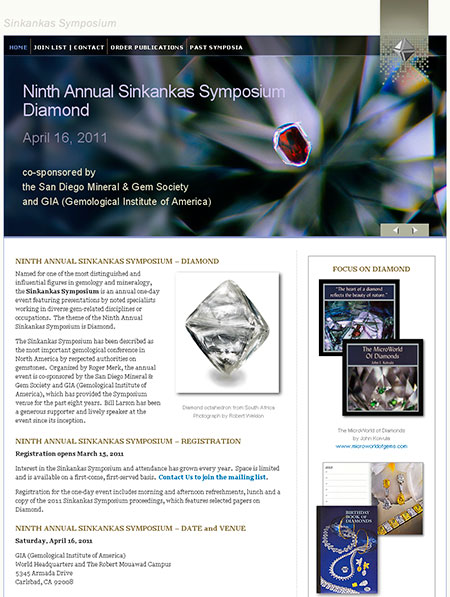 |
The nine presenters currently slated are recognized authorities in their respective fields. Visit the Sinkankas Symposium website for speaker bios and abstracts of selected presentation topics.
The Sinkankas Symposium is organized by Roger Merk, and co-sponsored by the San Diego Mineral & Gem Society and the GIA (Gemological Institute of America). It will be held Saturday, April 16, 2011, at the GIA World Headquarters and The Robert Mouawad Campus, 5345 Armada Drive, Carlsbad, CA 92008. Registration form available here. [back to top]
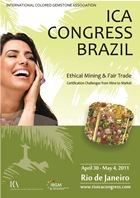 |
The International Colored Gemstone Association (ICA) holds its 14th biennial Congress in Rio de Janeiro this spring. The choice of Brazil is a timely one. According to an ICA press release, the country is “cited by Goldman Sachs to be among the four most dominant economies in the world by 2050, along with Russia, India, and China.” (Thanks for reminding us of where that leaves the U.S.…)
The conference begins its first full day of presentations, Monday May 2, with a focus on Brazil, including talks from the local host organization, IBGM (Instituto Brasileiro de Gemas e Metais Preciosos), as well as other local industry insiders. These presentations will touch on the Congress theme, “Ethical Mining and Fair Trade,” as well as environmental concerns.
Tuesday’s session will focus, in depth, on the Congress theme, with topics that include corporate social responsibilities, certification by the Responsible Jewellery Council, the Kimberly Process, and ethical supply chain, with the latter subjects speaking to the conference’s sub-theme, “Certification Challenges from Mine to Market.” On both Tuesday and Wednesday traceability of origin will be discussed—in general, and vis-à-vis tanzanite and emerald. Case studies, conservation, and education and fair trade will be addressed, followed by ICA business.
Presenters include: Dr. Gaetano Cavalieri, president of CIBJO; Michael Rae, CEO of the Responsible Jewelry Council; Eli Izhakoff, World Diamond Council Chairman and CEO of the Kimberley Process; Philippe Scordia of Dior Joaillerie; Robert Weldon, Andrew Lucas, and Vincent Pardieu from the Gemological Institute of America; ICA vice president and World Bank consultant Jean Claude Michelou; Douglas Hucker, CEO of the American Gem Trade Association; Gavin Pearce from TanzaniteOne; Ian Harebottle of Gemfields; Steve Bennett, CEO of Colored Rocks Limited.
More than 40 Brazilian gemstone producers and exporters will exhibit their products during the conference. A week of mine visits and more follows. For more information, visit ICA Congress Brazil website. [back to top]
This month we feature a ruby from a new deposit in Mozambique. This unheated red beauty is from the Montepues (aka Montepuez) area of Cabo Delgado Province, about 225 km. north of Nampula in northeastern Mozambique. This new source came along just in time as our legal stock of rubies from Burma has been running out. Since we can no longer import rubies from Burma, these fine natural rubies from Mozambique fill a perfect niche for those in the U.S. on the hunt.
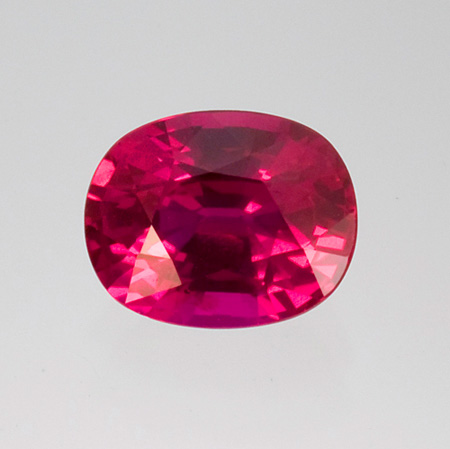 |
| Fine Mozambique Ruby: 3.16 carats , 9.11 x 7.31 x 5.55 mm., natural color and GIA certified. Inventory #18995. (Photo: Jason Stephenson) |
This 3.16-carat exhibits the finest properties from the deposit: fine natural red hue, virtually flawless and a beautiful make. A great alternative to a Burma ruby and the pricing is quite competitive. Pala recently bought a small parcel of these new rubies. See our selection of the new Mozambique rubies here.
Interested? Select inventory number above, call, or email us to inquire. [back to top]
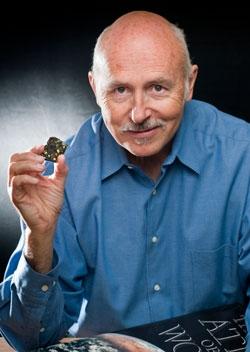 |
John Koivula, Chief Gemologist, GIA (Gemological Institute of America), will make a public presentation this coming Saturday afternoon at the Bowers Museum in Santa Ana, CA, at 1:30 p.m. The title of his presentation is “Macro to Micro: Inclusions and Gemstone Formation.”
Given the fact that most gemstone inclusions are small-to-microscopic, Koivula’s discussion of the macro level as well as the micro level should put the subject into an interesting perspective. He will describe how inclusions contribute to the value and beauty of gems, and how they can help to define the geological origins of their hosts.
The lecture is being presented in conjunction with the current exhibition, Gemstone Carvings: The Masterworks of Harold Van Pelt, which closes Sunday, May 1.
For tickets and more information on this Distinguished Lecture by John Koivula, visit the Bowers Museum website. [back to top]
Someone made their valentine very happy on February 14. The EKATI Spirit, a 78-carat diamond crystal from the EKATI Diamond Mine in Canada’s Northwest Territories, sold for more than $2.8 million at auction in Antwerp. The crystal measured 21 x 18 x 13 mm., about the size of the top joint of a man’s thumb.
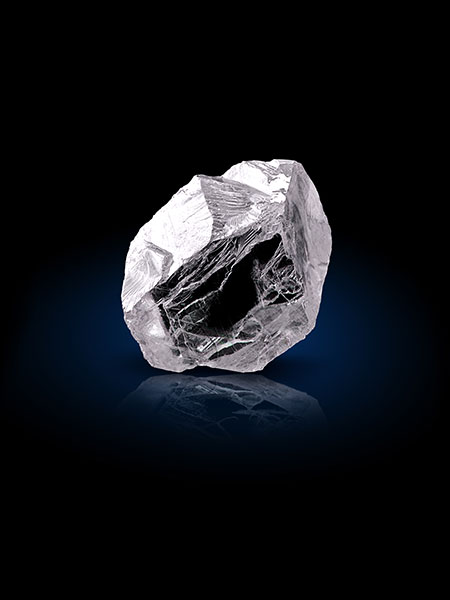 |
| The EKATI Spirit may not be the largest produced by the EKATI Mine (that was a 182-carat stone of poorer quality), but it is the most valuable, from a mine that yielded a million carats in its first two-and-a-half months of production in late 1998. It set a Canadian record for a single diamond. (Photo courtesy BHP Billiton) |
The stone was termed “internally flawless” by Alexander Legaaree, a spokesperson for Australia’s BHP Billiton, which owns the mine, according to Postmedia Network. It was discovered last October and named by Terry Marshall, a warehouse technician, following a company-wide naming competition. the stone is the most valuable to be produced in the mine’s 13-year history. The sale, which was offered to 70 select buyers, was held at the company’s diamond sales center in Belgium. The buyer’s identity was not released. More information on the mine is available at the company website. [back to top]
One of the largest tanzanites ever uncovered was announced on March 1 by TanzaniteOne Ltd. The 12,100-carat stone was unearthed in the Simanjiro District of northeast Tanzania’s Manyara Region, according to a story on JCKOnline. It is perhaps the third largest tanzanite ever found.
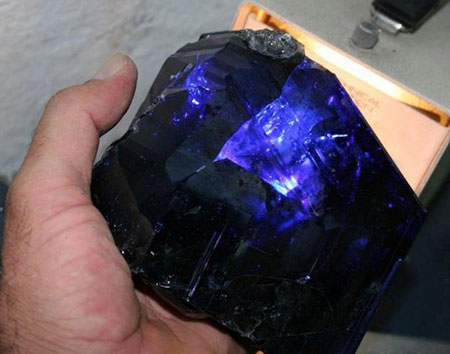 |
| Indiglow. TanzaniteOne probably will use its in-house cutting facility for the large crystal. (Photo courtesy TanzaniteOne) |
According to JCKOnline, the stone will be graded, with the expectation that it will contain much “A grade” material. (TanzaniteOne’s promotional affiliate, Tanzanite Foundation, has a guide to grading and valuing.)
Not long before the above find, the Bank of Tanzania on January 1 issued a new series of bank notes, including the 5000-shilling bill pictured below. The obverse portrays a black rhinoceros; the reverse portrays the Geita Gold Mine (according to Wikipedia), and tanzanites: a crystal, and two faceted stones (misidentifed on Banknote News as diamonds).
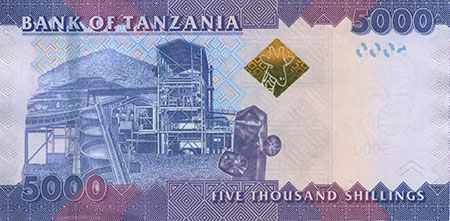 |
| Tanzanian bank note displays tanzanite images, above. Click images to enlarge |
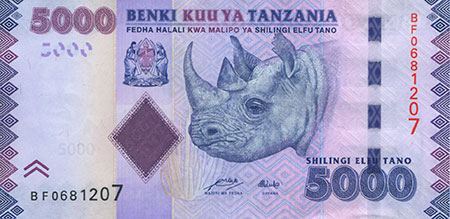 |
The previous 5000-shilling note portrayed the gold mine and the landmark building The House of Wonders in Stone Town, Zanzibar, on the reverse, and a different rhinoceros on the obverse. [back to top]
A February 11 notice from Greene Broillet & Wheeler, LLP, representing clients in the ongoing “Bahia” Emerald dispute state that opening briefs are due in court today, and reply briefs are due March 30. A date for closing arguments has not yet been scheduled.
 |
| Tiffany blue. Stock prices may have fallen, but Tiffany owns its exclusive hue of blue. |
Just three days after LVMH (LVMH Moët Hennessy • Louis Vuitton S.A.) had been given the green light to acquire Italy’s iconic Bulgari, as reported by JCKOnline March 7, Reuters revealed that Tiffany may be the next takeover target. Then, in what is said to be a response to the earthquake in Japan, Tiffany and Co. stock fell on March 14 and 15. Japan’s luxury goods purchases are 11 percent of the global market; Tiffany receives 19 percent of its sales there, according to a story yesterday by Reuters, which also stated that other companies have been affected. Tiffany outlets are not in earthquake-ravaged areas.
In December 2008, we mentioned a $102-million robbery of Harry Winston’s near Paris’s Champs-Élysées. The 15-minute job was done by four men disguised as women “with long blond tresses, sunglasses and winter scarves,” who addressed employees by name. About 80% of the haul was tracked down. The rest was recovered this month from a drain at a house in the suburb of Seine-Saint-Denis, northeast of Paris, according to the Guardian March 9. Originally suspected as being members of a Yugoslavian gang, it was determined that the robbers had spoken with banlieue (literally “suburb”) accents, leading police to one of Paris’s poorest nearby neighborhoods.
 |
| Kashmir blue. The classic that Kashmir—thirty years on—is still famous for. Inventory #15613. (Photo: Wimon Manorotkul) |
The Jammu and Kashmir state government in northern India continues to set the stage for renewed extraction of its famous sapphires, according to a PTI (Press Trust of India) story on Sunday. The government is pushing for global tendering to insure competitive bidding on a large scale, with maximum transparency, claiming that one unnamed global company has signed on. The state’s Jammu and Kashmir Minerals Ltd. holds the mining lease for 6.65 square kilometers at the famous locality of Padar. According to Richard W. Hughes, the area has long been considered “rebel territory” due to its status as disputed territory between Pakistan and India (see Hughes, Ruby & Sapphire, p. 359, “Timeline of Kashmir sapphire”). The PTI article tied the thirty-year delay to “extreme geographical conditions and lack of resources.” Note the dates on the J&K Minerals website’s "Golden Opportunity for Mining of World Famous Sapphire…” inviting expression of interest: 2005 and 2004. We wonder when the second global company will get on board. [back to top]
In early March we received notice of an encouraging and creative way that jewelry appraisers were supporting people in Christchurch in the aftermath of last month’s earthquake: donate all the fees you received on the day of the quake, February 22, to the NZ Red Cross Earthquake Appeal. The Association of Independent Jewellery Valuers made the appeal on its March 1 blog entry, which has received several comments from appraisers to took up the call. Colleagues are running Valuation Saturdays—including one March 19—with all fees going to the above earthquake fund, according to this Facebook page.
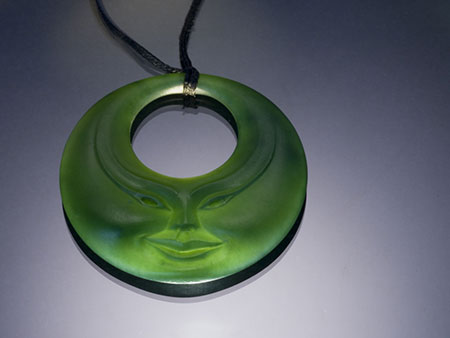 |
| New Zealand has given much, such as this sublime carving of native nephrite by the masterful Donn Salt. Let us give back, too. (Photo: Wimon Manorotkul) |
A week after receiving the New Zealand appeal, a hemisphere away, more devastation—in Japan.
Pala’s Will Larson has spent much time in Japan. Yesterday, while traveling, he shared his feelings.
How does one respond to such a tragedy? I myself reacted in a defensive way. My body shut down, became unresponsive and hid from the pain, numb without feeling. Soon this turned to sadness and overwhelming emotions. Nothing like feeling so small in a time like this to make you realize what’s important in life.
The last few days have taxed me; I’ve been on an emotional roller coaster hearing news from Japan in bits and pieces. Desperately trying contact friends and to discern whether they and their families were alive after the earthquake and the following tsunami. Initial contact was very difficult as most phone services were down and power was out in many areas, but thanks to social media networks and email I was able to establish contact with most of them within 48 hours. After getting through to Japan I discovered only a few were missing or hurt, most survived without a scratch just emotional scars. Sadly some are still missing; after this much time it’s not looking good. Now with the nuclear radiation explosion, it’s been tough few days.
My thoughts are constantly with Japan and my friends and their families.
I wrote this poem in wake of the destruction in hopes of inspiring my friends and I will share it with you.
Smile, Nihon
Smile, smile, smile
Today’s another day
Take a step forward you’ll find another way
Smile-smile-smile
I’ll see you someday
Nobody stands stronger
In situations like these,
Have you seen how they come together?
Only time can heal...
Now to move forward!
— Will Larson
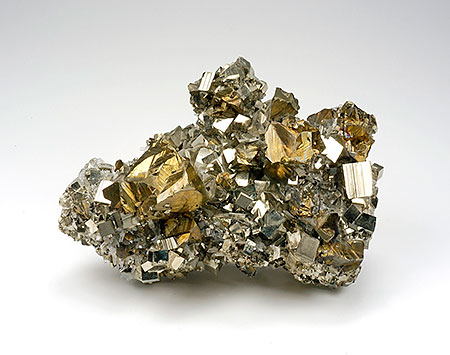 |
| Chalcopyrite on pyrite, Arakawa Mine, Akita Prefecture. From the Japan collection of Will Larson. (Photo: Wimon Manorotkul) |
Please consider giving a day’s fees or profit to
[back to top]
 |
| Natural Burma spinel, 2.08 carats, from our Old Stock… New Pix, courtesy Pala photographer Jason Stephenson |
Last week’s 48th Annual Myanma Gems Emporium caused gem merchants to claim that jade prices have soared, according to a March 14 story posted by Democratic Voice of Burma. The prices didn’t dampen sales: a merchant was quoted as saying that jade worth 200,000–300,000 kyat ($230–$340) three years ago now was worth 1.5 million to 2 million kyat ($1,705–$2,272). Pearls also sold well. The sale is being held March 10–22 in the administrative capital of Nay Pyi Taw.
An undated item by Eleven Media Group (EMG) stated that twice the amount of jade would be sold as at earlier sales. It also reported that tax would be levied on only ten percent of sales by local merchants. Another EMG story claimed that the sale would offer 16,000 jade lots, 206 assorted gems lots, and 29,000 pearls from 500 local merchants. Over four thousand foreign gem merchants were said to be attending. A third EMG article stated that 20,000 jade lots would be offered—twice the number displayed in November.
Top Burma officials attended the emporium, which was reported March 9 on the front page of the state-run New Light of Myanmar newspaper, which of late has not covered such visits in such a high-profile manner. Ten photos from the emporium—some suggesting the high quality of the jade—were posted March 10 by The Irrawaddy.
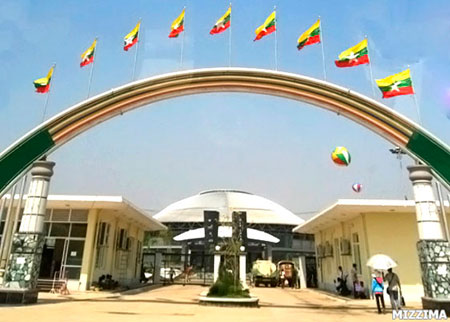 |
| The Mani Yadana Jade Hall in Nay Pyi Taw, the site of the emporium. (Photo courtesy Mizzima) |
…but not in Japan—in China. Hundreds of Burmese jade traders fled to Burma’s border town of Ruili when a 5.8-magnitude quake struck March 10 in Yingjiang County in southwest China’s Yunan Province, according to Kachin News Group. According to the story, the market in Yingjiang is the second largest on China’s border for Burma’s merchants, who sell jade from Hpakant in Kachin State. Recovery work following the quake was covered March 14 by China’s People's Daily Online as well as a half-dozen other stories.
…since there’s been so much to cry about, from the satirical website, Not The Nation: “Why It Just So Happens I Own A Gem Shop.”
 |
| Natural Burma sapphire, 3.05 carats, Inventory #13690. (Photo: Mia Dixon) |
[back to top]
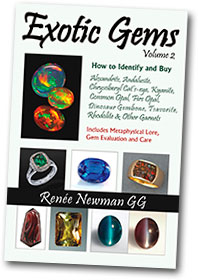 |
Less than a year following our review of Volume 1 of her Exotic Gems, author Renée Newman has published Volume 2. This companion volume includes alexandrite, chrysoberyl cat’s-eye, andalusite, kyanite, sillimanite, common opal, fire opal, dinosaur gembone and the garnet family, including rhodolite, tsavorite and demantioid.
Newman begins the book again with a discussion of the term “exotic,” defined by one dictionary as “of foreign origin or character” or “striking or unusual in effect or appearance.” But then she asks six people for their own definitions. As a Parisienne puts it promptly, “For the French, ‘exotic’ gives rise to dreams….” Indeed, it strikes us that this is the power of gemstones, as tangible objects: to lead us through our psyches’ imaginary, and alien, landscapes.
Take, for example, the image of freeform fire opals and water opal from Mexico on page 11. The colors are so radiant and near-complementary that the image becomes stereoscopic (3D glasses not needed; you’ll have to get the book to see what we mean). The fact that vivid opal can lurk within matrix, as Newman mentions in the section on fire opal (Ch. 10, p. 91), truly takes us on a journey to the center of our minds.
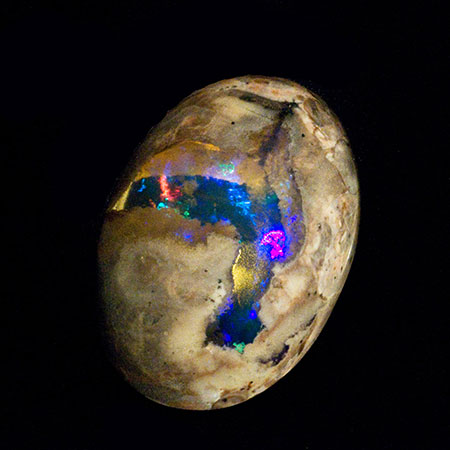 |
| This opal in matrix above (not from the book), photographed by Pala’s Mia Dixon, compels us to look below the surface, as does the one below, photographed by Juan José Virgen for Opalos de México, included in Exotic Gems, Volume 2, p. 91. |
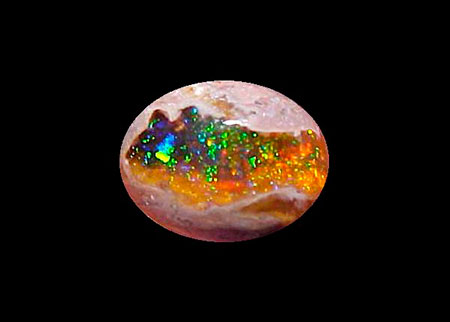 |
“Even though several opal books have been written,” Newman told us, “they have focused on Australian opal.” Newman saw a need for additional information on both fire (mainly from Mexico) and common opal, and therefore included two chapters on these opals. We’re happy she did: the variety of fire opals displayed and discussed abound—from the subtle rainbow effect of contra luz in otherwise glassy opal, to the coral-like formations of Pala’s July 2007 featured fire opal (included on p. 84), to treated tizate (chalk) opal that loses its intriguing inkiness when immersed in water. Synthetics, imitations, identification (and misidentification) tips also are provided, as well as descriptions of the many treatments, geographic sources, pricing and evaluation, care suggestions, and metaphysical lore (fire opal prevents burn-out!).
 |
| Common opal (with no play of color) moves into the realm of the exotic when one considers its many colors, such as these prase opals from Tanzania, photographed by Pala’s Jason Stephenson, included in Exotic Gems, Volume 2, p. 63. |
If opal still isn’t exotic enough for you, Newman looks at…
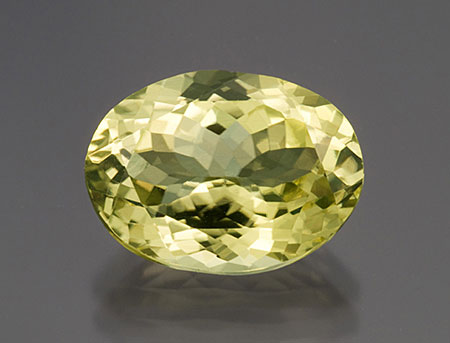 |
| Hard to believe that sillimanite (8.21 carats, above) and kyanite (3.52 carats, Nepal, below) are often so fibrous as to be opaque. Photographed by Pala’s Mia Dixon, included in Exotic Gems, Volume 2, pp. 58, 52. |
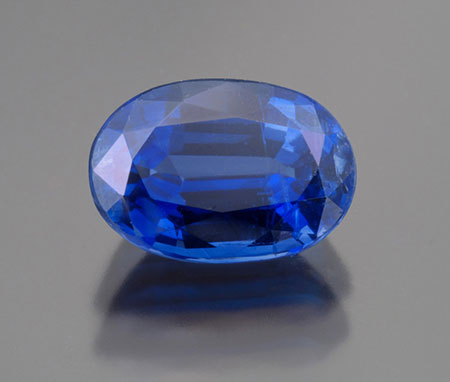 |
And more…
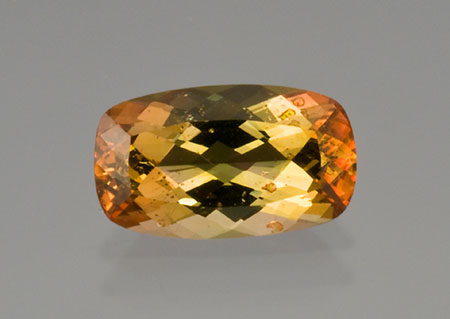 |
| This andalusite, 3.11 carats from Brazil, demonstrates strong pleochroism—naturally. Photographed by Pala’s Mia Dixon, included in Exotic Gems, Volume 2, p. 48. |
The last six of the sixteen chapters are devoted to garnet, in its amazing number of varieties.
Chapter 11, which provides an overview of the garnet group, includes a five-page photo section showing the steps involved when master cutter Clay Zava cuts a garnet.
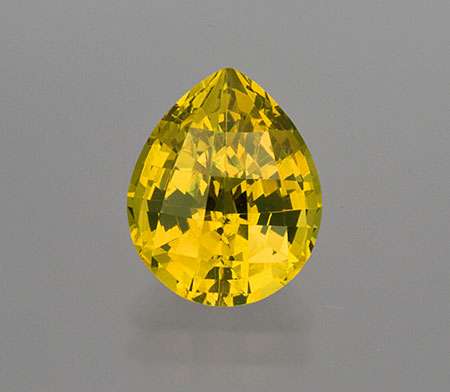 |
| A grandite (5.37 carats, Mali, above) and rainbow garnets (freeform 56.08 carats, oval 23.53 carats, Sonora Mexico, below) are but two examples from a group that contains six mineral species used as gems. Photographed by Pala’s Mia Dixon, above, and Wimon Manorotkul, below, included in Exotic Gems, Volume 2, pp. 144, 118. |
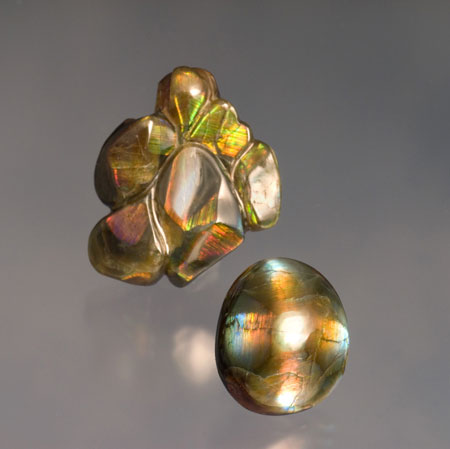 |
The book is a manageable 154 pages—surprisingly compact given the breadth of information—with 408 color photos and photomicrographs of rough material, cut stones, and lovely jewelry, along with many helpful tables and diagrams. It also contains resources for finding an appraiser (and questions to ask), as well as a four-page bibliography.
The book can be purchased at major bookstores and jewelry supply stores, or via the link on the author’s website. [back to top]
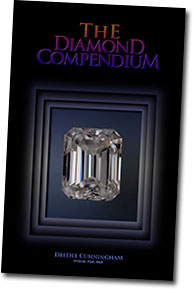 |
We received the following information from the publisher of a new book released just in time for the Ninth Annual Sinkankas Symposium – Diamond…
Sought after, fought over, hoarded, hidden and stolen; diamonds remain one of mankind’s greatest obsessions. Diamond represents the most concentrated form of wealth on the planet and the hardest known natural substance.
Covering everything from the origin of diamonds and their properties, through mining, the four Cs of grading and marketing, to modern high-tech treatments, fancy coloured diamonds and synthetics, The Diamond Compendium presents the body of diamond knowledge in a simple and understandable way.
Written by a diamond expert, this book is based on thousands of hours of research with specialists worldwide. Whether you are using this book to learn the facts about purchasing diamonds, understand the trade, prepare for formal examinations or simply satisfy your curiosity, The Diamond Compendium is the most thorough, absorbing and comprehensive book on the market.
About the Author: DeeDee Cunningham (FCGmA, FGA, DGA) is holder of professional diamond and gemmology diplomas from Great Britain and Canada. Recipient of multiple distinctions, she was awarded the W. Donald Goodger Prize upon graduation from the Canadian Gemmological Association in 1995. She lives in Toronto and works with her own company Burgundy & Ballantine Inc.
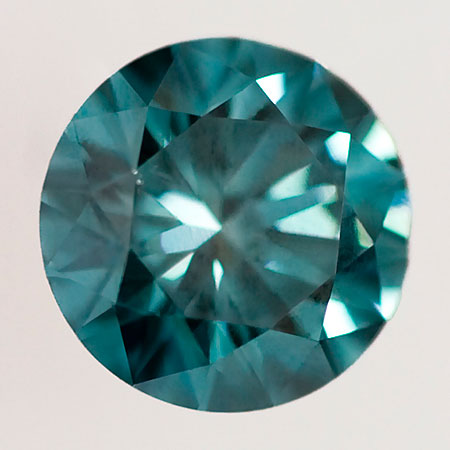 |
| From the book: Irradiated and annealed blue. |
The book is available from the publisher and major booksellers. See also the book’s website.
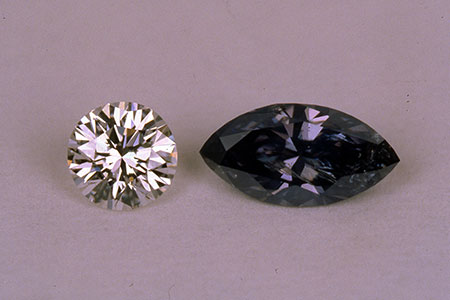 |
| Fancy Violet: Note the surface reaching fractures. (Courtesy of Stephen Hofer) |
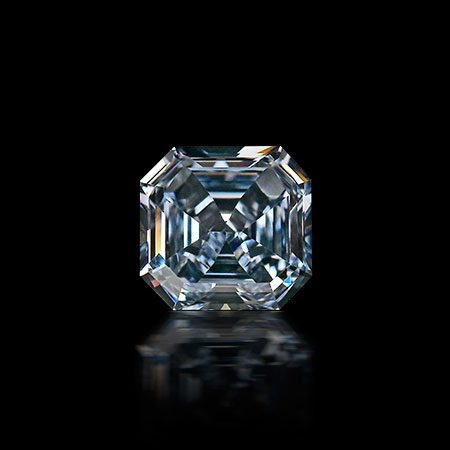 |
| From the book… a fancy blue diamond. (Courtesy of Arthur Langerman) |
[back to top]
— End March Newsletter • Published 3/16/11 —
This edition of our newsletter finds us back in clement California after arctic Arizona—but we’re not complaining. Things went so well that we’re featuring a Pala first: our featured stone was sold before we could get this to press, but we thought we’d share it with you nonetheless. We’re pleased also to share with you a remarkable 34-sided tour de force, courtesy Lawrence Stoller. And you’ll be pleased, if you’re not subscribed to our sister publication, Pala Mineralis, to take a look at two books on two gemstones, one named for a little tsar, one for a little thorn.
In the introduction to this month’s edition of our bi-monthly e-newsletter, Pala Mineralis, we wrote,
At the time of this edition of Pala Mineralis Tucson show attendees are enjoying an escape from the severe weather that grips the Midwest to the East Coast. We wish all our snowbound friends the best.
The next day, Pala’s Bill Larson sent us this photograph, taken on the grounds of the Westward Look resort, which was preparing to host its famous show:
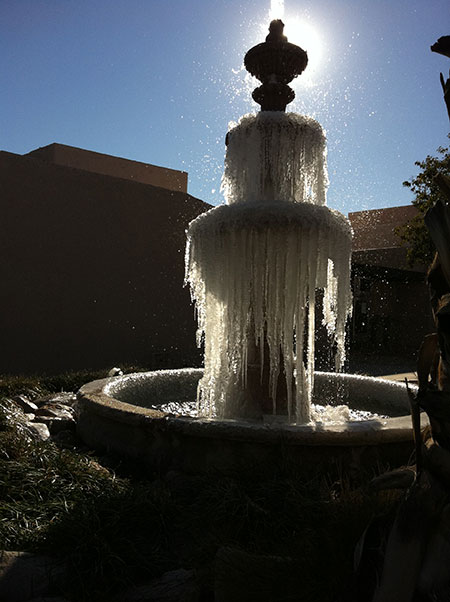 |
But if things were frosty outside, they were sizzling inside, at the America Gem Trade Association (AGTA) GemFair. “We had a ‘Monster’ show,” Pala’s Gabrièl Mattice told us. “It was so nice to feel an enthusiastic mood from everyone—dealers and customers alike.” Indeed, AGTA reported last Thursday that, despite the weather that kept some would-be attendees homebound, “[b]uyer attendance was up 5% over 2010, building on a 7% increase from the previous year.” AGTA CEO Douglas T. Hucker raved that “the real success of the show was the atmosphere on the show floor, with a significant upswing in buying activity.”
  |
| Tucson treats. Samples of the sort that AGTA GemFair buyers bought (but didn’t, i.e., they’re still available). And our “not to scale” caveat was never more applicable. Left, a whopping 70.75-carat heated treat from Mozambique, Inv. #18500. (Photo: Mia Dixon) Right, a natural 11.94-carat cuprian tourmaline, also from Mozambique, Inv. #15219. (Photo: Wimon Manorotkul) |
Gabrièl mentioned that Pala “also had a few very unusual stones that were held back as a treat for the avid collectors who know that we always have the fun ones stashed.” Sometimes it pays to ask... And what was hot? “Tourmaline,” Gabriél says, “was a big splash as usual,” likely given the fact that material from Mozambique is becoming rarer and rarer.
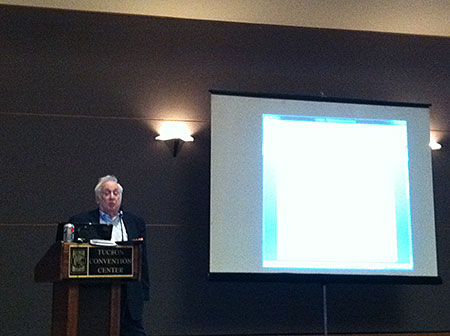 |
| Gene Meieran sets up for the meeting of a new, and as yet unnamed, mineral organization Saturday in Tucson. Beginning his collecting in 1949, in his father’s Norway, Meieran for the last twenty-some years has specialized in “high-quality gem species and native element crystals,” according to his profile at The Mineralogical Record. While a graduate student at MIT, Meieran rescued two large topaz crystals from being cut for use in X-ray monochromators; the crystals now are in the Smithsonian’s collection. Meieran contributed the afterword to American Mineral Treasures. (Photo: Bill Larson) |
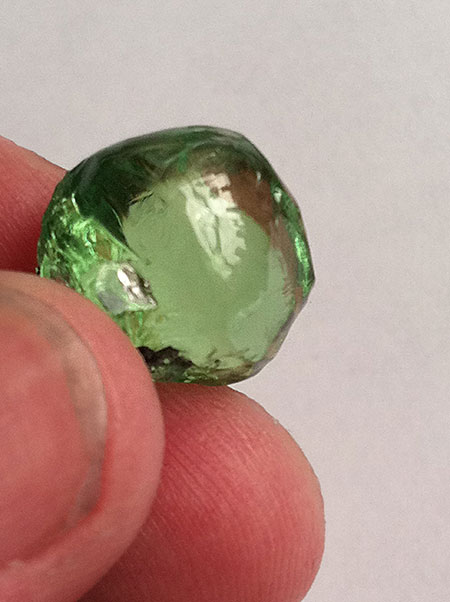 |
| From the Emerald Aisle at Pala International’s booth at Tucson, this 26-carat garnet nodule from Tanzania was acquired by a lucky buyer. (Photo: Bill Larson) |
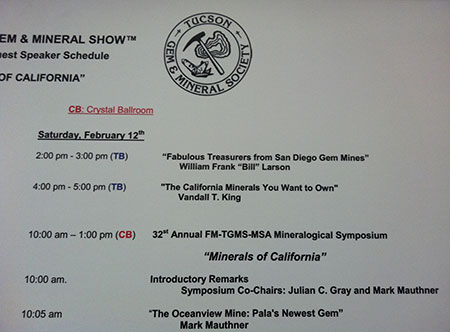 |
| Pala’s Bill Larson spoke last Saturday afternoon to a packed house at the Tucson Gem and Mineral Show. |
[back to top]
Spinel has become increasingly popular, due in part to all the wonderful natural colors it produces. The more common colors are the red hues with secondary colors mixed in—like orange, purple and pink. To find pure red in spinel is probably even more rare than finding a pure red ruby. There just simply aren’t as many spinels coming out of the ground, so to find pure and intense natural colors seems to be on the wish list for many new collectors.
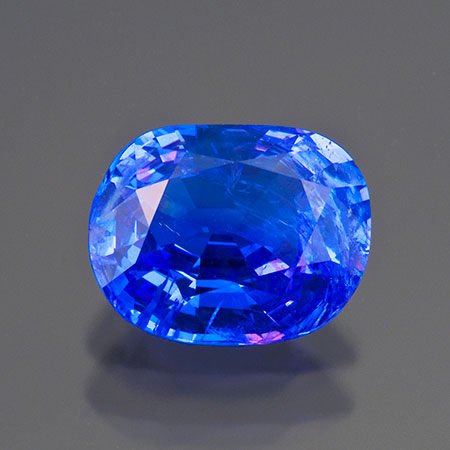 |
| Blue spinel from Vietnam, 2.59 carats, 9.0 x 7.0 x 4.8 mm. Note: This stone has been sold. (Photo: Mia Dixon) |
When we shift over into the blue hues the scarcity increases and we weed through many over-dark grayish-blue spinels until we find these blistering cobalt-blue jewels. In fact, we even had this most recent blue spinel (above) tested for cobalt at the Tucson show, at the GIA Show Service Laboratory. In the end the lab was able to find the presence of cobalt through the Chelsea filter, which glowed cherry red when illuminated.
This collector’s dream really didn’t even have a chance of making it into our inventory; there was a line of people who wanted it and it has already found a home. However, we still wanted to share the excitement of such a spectacular and rare gem with our loyal readers.
Interested in something similar? Call or email us to inquire.
See our latest selection of spinels here. And see a notice about a new book on spinel below. [back to top]
Lawrence Stoller carves crystals—by hand. And he doesn’t mind a challenge, likening it to “setting sale for a new land.” “There is that feeling of freedom and discovery,” he wrote in December on his blog, “and a momentary bliss of blind exuberance as we launch into unknown territory.”
But when a client approached him about cutting a 34-sided smoky quartz crystal, his “can do spirit” turned to problem solving. Twenty-four sides, he wrote, would be a logical extension of the crystal’s hexagonal structure. The client, however, had personal reasons for needing 34. But, again, Stoller carves crystals by hand…
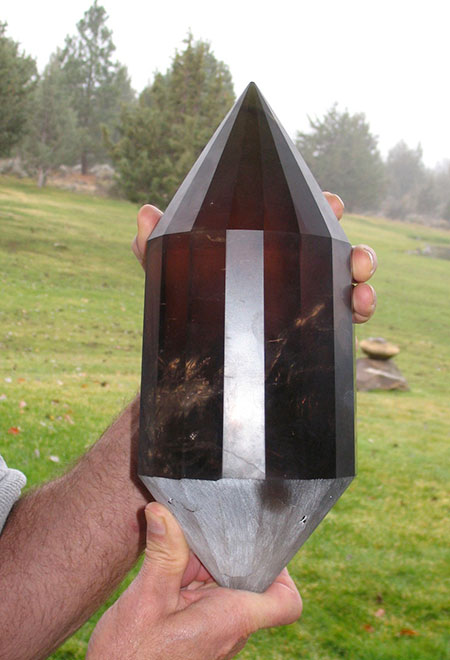 |
| 34 ÷ 2 = 17. Cut from a 43-lb. smoky quartz crystal, the triacontakaitetragon above is at the “halfway” point, a mere heptakaidecagon. (Photo courtesy Lawrence Stoller) |
A 34-sided crystal—known as a triacontakaitetragon—of the size specified by the client would be more easily faceted using a machine such as the one we highlighted in the “Facetnating” section of our Pala Turns 40 feature. But Stoller carves by hand. Such a method, in his estimation, deprives the finished work of that je ne sais quoi “achieved through a relationship between the hands of the cutter as he or she listens to and works in consort with the crystal.” Stoller’s presumably unintended use of that particular C-word actually implies an intended intimacy. Stoller offers many insights into the ars amandi as he chronicles the journey from conceptualization to audition to execution in painstaking detail on Crystalworks.com. [back to top]
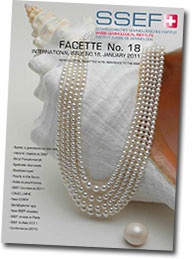 |
SSEF Swiss Gemmological Institute has released its annual compendium of gemological information, Facette. This edition includes the following topics.
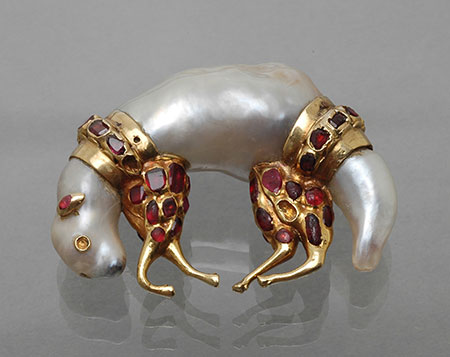 |
| Fabulous creature? This brooch probably originates from the 16th to 17th centuries. The body consists of hollow pearls and the garnets are possibly of Bohemian origin. Despite a seal-like appearance the creature’s tiny cloven hooves, below, suggest the representation of a sheep. (Photo © SSEF) |
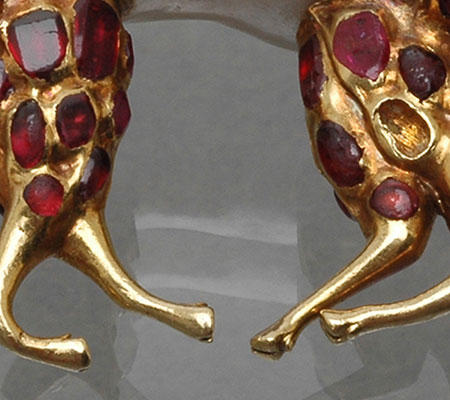 |
[back to top]
The latest export statistics were released February 1 by the Trade Development Authority of Pakistan, covering the last six months of 2010. The total for gems and jewelry combined saw a drop of 19.3%. Gems alone increased by 3.14%, while jewelry declined by 19.42%. Gems are a tiny fraction of the total—$1.5 million versus $286 million for jewelry. Both sectors missed their targets, gems by 25% and jewelry by 22%.
Statistics were on the lips of Pakistan’s Federal Minister for Industries and Production, Mir Hazar Khan Bijarani, as he opened a two-day Gem Bazaar early last month in Islamabad. The minister announced an ambitious target of increasing “gemstones” exports (presumably also including jewelry) from $300 million to $1.5 billion by 2014, according to a January 6 article in Dawn.
Behind the ambitious goal:
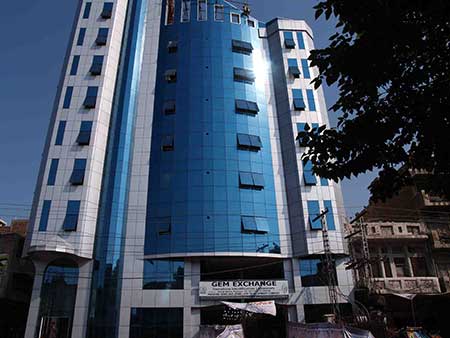 |
| The Gem Exchange of Peshawar is in close proximity to the famous Namak Mandi gem market (see Vincent Pardieu’s 2006 visit). It houses gemological labs but also marketplace training settings. When they are opened to the public, these are real-world gemstone bazaars. (Photos courtesy PGJDC) |
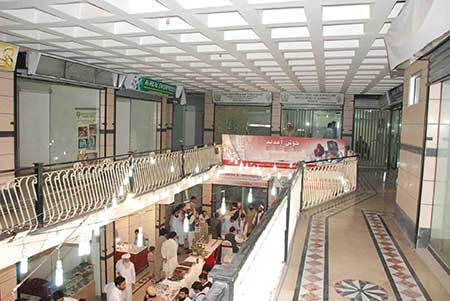 |
Gem Bazaars take place often at the Gem Exchanges of Peshawar and Quetta, as well as at the training and manufacturing center at Lahore. January’s sale was the first in the capital of Islamabad. Exhibitors from across Pakistan included about 125 dealers, distributors, exporters and retailers.
The Pakistan International Gems and Jewellery Exhibition, scheduled for last August, was postponed due to massive flooding in the country.
A February 4 article, also in Dawn, quoted figures released by China Customs: exports to China from Pakistan rose by $500 million during calendar year 2010, to $1.7 billion from $1.2 billion in 2009. To help solve a trade deficit with China, according to the article, Pakistan has requested vocational and technical training in gems and jewelry.
Gems and Gemological Institute of Pakistan, Peshawar website had a nice makeover since last we visited. The Institute offers courses in gemology, faceting and carving. [back to top]
Eleven Media Group (EMG) reported in an undated story that 40,000 pearls would be offered at a pearl emporium that was to be held January 11 to 13 in the administrative capital of Nay Pyi Taw, at the Myanma Gem Museum there. They were to be offered via tender and bidding in kyat currency. According to the article, this emporium was the fourth to be held in Nay Pyi Taw, and the 30th held in Burma. Post-sale results were not located.
 |
| Natural spinel from Burma, 4.54 carats, from our Old Stock… New Pix, courtesy Pala photographer Mia Dixon. |
Another EMG story looked at the Yangon tourist spot of Bogyoke Aung San Market (named after the father of Aung San Suu Kyi, who fought for Burma’s independence). The market “is now teeming with world tourists,” according to the article, after a mid-year slump that continued through last fall’s general elections, but picked up during the Christmas/New Year holiday season. Window shopping, isn’t buying, however, and sales have not yet increased.
Some gem merchants interviewed at the market by The Myanmar Times (MT) were quite optimistic about the tourism resurgence. One merchant even felt that the market in Nay Pyi Taw—in addition to those at Bogyoke and Mandalay—was a boon, allowing him to purchase rough stones in the capital, polish them in Yangon, and then sell them again in Nay Pyi Taw. “I tripled my money on those gems,” he told MT.
 |
| Natural Burma ruby, 6.7 carats, also from Old Stock… New Pix. |
But a sort of a corundum conundrum has surfaced at the market—the kind that would make Lawrence Stoller wince. While tourists “seem to value handmade works” and love to watch traditional hand-polishing methods in the market, domestic buyers prefer machined gems. The fear amongst industry insiders is that Burma’s hand-faceting could be eclipsed by industrialization of the craft, leaving Burma in the dust created by China and Singapore as those countries march forward on the Path to Progress.
According to Xinhua News Agency on Monday, Nay Pyi Taw hoteliers are still preparing for the 13-day gems emporium to be held March 10–22. But buyer beware if you add gold to your shopping cart: Burma’s customs department has restricted how much gold jewelry that air passengers can take off with. And a “gold ring shall not be inserted with any kind of gem or jade stone,” according to the article, which referred to a February 3 story by Yangon’s Popular News.
The issue of sanctions against Burma has become such a hot topic in the weeks since the release of Aung San Suu Kyi, that even the non-governmental (but tightrope-walking) online weekly The Myanmar Times has taken up the issue, as it did in its current edition. It seems everyone is critiquing the wisdom of continuing bans that even proponents admit aren’t working. For instance, Democratic Voice of Burma last month published an analysis titled “Sanctioning sanctions?” that provides a history of the tactic vis-à-vis Burma, observing that sanctions have been applied usually as a reactive measure, and concluding that only “targeted” sanctions (e.g., against banks) could impact the country’s regime.
The Myanmar Times (MT) article, “Sanctions statement off the mark,” follows Suu Kyi’s National League for Democracy (NLD) report on sanctions, published last week. The report cited the International Monetary Fund, which “does not see sanctions as a significant factor in regard to the economic problems of the country.” Both the report and MT cite the garment industry meltdown of the mid-2000s, with the NLD claiming that “[o]f that loss, only about 2.5% was related to labour wages”—not surprising when wages in Burma never have been high. MT, in turn, reminds its readers that, according to a local trade group, the “sanctions left more than 85,000 garment industry workers jobless.”
This is but one example of the “he-said-she-said” that typifies the debate. One conclusion of the NLD report, however, is a call for the organization to discuss and study, with the U.S., E.U., et al., modifications “in the interests of democracy, human rights and a healthy economic environment.” [back to top]
We’re pleased to reprint the following two items, which were featured earlier this month in our bimonthly sister publication, Pala Mineralis.
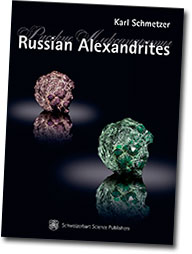 |
In September, we featured a notice regarding the impending publication of Russian Alexandrites by Karl Schmetzer (with contributions from George Bosshart, Marina Epelboym, Lore Kiefert and Anna-Kathrin Malsy). For this edition of our newsletter we thought a scholar's perspective on the volume might be interesting, so we approached Lisbet Thoresen, whose own work on gemstones, especially their historical background—discovery, naming and use—are prominent topics in this book.
The book is available from the publisher.
 |
| Portrait of Tsarevich Alexander II on horseback. Painting by Egor Botman after Franz Krüger, ca. 1850, Hermitage Museum, Saint Petersburg. (Photo: Karl Schmetzer) |
The history of alexandrite has been shrouded in mystery and obfuscation since its discovery in the Urals, Russia, in 1833. Despite its commercial value and desirability as a rare collector gemstone, mineralogical studies on this color-change variety of chrysoberyl, especially the Russian material, have been limited until recently. In 2010, Dr. Karl Schmetzer produced a comprehensive and authoritative book on this subject entitled Russian Alexandrites. For the first time, this book reconstructs an accurate history of the gemstone through original letters and reports translated from Russian, French, Swedish and German, as well as historical photographs obtained from obscure archives. This book also provides an insight into the study of minerals of the 1830s to 1850s, when mineralogy was just beginning to become a science.
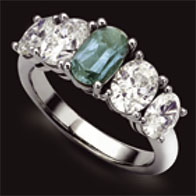 |
Ever since its discovery, access to material for study has been difficult, which may explain, in part, the paucity of mineralogical data published to date. The historical background on alexandrite, however, has been richly embroidered—from its actual date of discovery to its recognition and correct characterization as a distinctive new variety of chrysoberyl. The mining operations from the earliest ventures until the present day, likewise, have a storied history, much of it obscured under the cloak of secrecy during the Communist era.
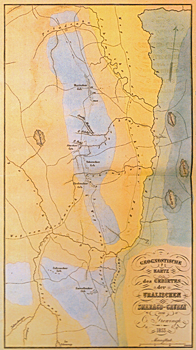 |
| The first geological map of the emerald and alexandrite mining areas north and south of the Tokovaya River was published by Grewingk in 1854. |
Marina Epelboym and Karl Schmetzer frame the story first by describing the geological setting in which chrysoberyl and alexandrite (and also phenakite) were discovered—as associated minerals in the emerald bearing zones of the Izumrudnye Kopi belt, or Tokovaya area, northwest of Ekaterinburg, which, after Colombian sources, are the most commercially significant historical emerald deposits in the world. Always regarded as a secondary mineral to emerald, Schmetzer estimates the ratio of emerald to alexandrite ranges between 100:1 and 200:1. Because the primary mining interests focused on emeralds, the history and development of the Russian mines where alexandrites were first discovered inextricably interweaves the story of alexandrite with that of some of the most important emerald specimens ever found. This aspect of alexandrite’s history is taken up in the book’s next chapter by Schmetzer.
The principal author provides a fluid narrative relating the history of the famous emeralds recovered from the Tokovaya area and their passage through the hands of illustrious collectors and museums, including the Kokovin emerald, a 400 gram emerald that was lost or stolen in 1835; the Leuchtenberg emerald druse, a group of 20 crystals en matrix found in 1831 and weighing 6265 grams (first published by von Pott in 1842); the Kochubei emerald, found in 1831 at the Sretensky Mine and weighing an astounding 2226 grams. Among the alexandrite finds, the most important ones were all discovered prior to 1840, and pre-eminent among them is a crystal group known as Kochubei’s druse (pictured below). Also in this same chapter, Schmetzer chronicles the discovery, naming and uses of Russian alexandrite in the 19th century. Named in 1842 in honor of the Tsarevich, the future Tsar Alexander II of Russia (r.1855–81), the author also presents the correspondence, publications, photographs and drawings that establish an accurate timeline and context concerning alexandrite’s early history.
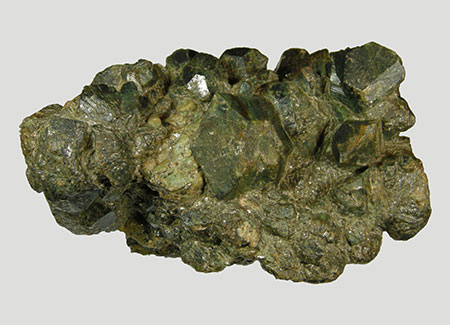 |
| The most famous and largest alexandrite crystal group ever found in Russia is known as Kochubei's druse. It was discovered in 1939/40 at the Krasnotbolotsky Mine and first described and pictured in a book by the pre-eminent Russian mineralogist and crystallographer of the 19th century, N.I. Koksharov (1862), Materialien zur Mineralogie Russlands, Vierter Band, and in a monograph by the same author in the same year, now in the Fersman Mineralogical Museum, Moscow. (Photo: Karl Schmetzer) |
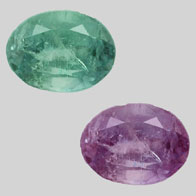 |
In 2005, the Tsar Emerald Corporation, a Canadian company, secured licensing agreements to operate the Malysheva Mine, one of the seven principal mining sites which were discovered prior to 1840. In 2007, Dr. Schmetzer and Dr. Lore Kiefert were able to visit the mine and perform the first mineralogical studies on specimens that had been unearthed after 2000 from the Malysheva Mine. As volume editor and principal author of Russian Alexandrites, Schmetzer has drawn together data gathered on alexandrites and yellowish green to yellow green chrysoberyls in various collections, both private and public, in Russia, Germany, Austria and Great Britain—covering material from a time period spanning more than 175 years. Gemological, mineralogical, morphological and colorimetric data are presented in separate chapters, each detailed and copiously illustrated with color plates, photomicrographs, spectra, schematic diagrams, plots and charts.
Chapter 6 presents gemological and mineralogical studies performed by Schmetzer and Kiefert, which employed analytical tools, including electron microprobe, SEM-EDX, energy-dispersive X-ray fluorescence (EDXRF) and micro-Raman spectroscopy in order to obtain quantitative data and corroborative identification of inclusions. Numerous photomicrographs complement the discussion of alexandrite’s inclusions, distinctive growth structure and twinning.
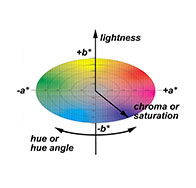 |
| General outline of the three-dimensional CIELAB color space with parameters shown for hue, hue angle and chroma. (Artwork: Karl Schmetzer) |
Beginning with a discussion of the early work of mineralogists on the recent finds from the Central Urals, in Chapter 5, Schmetzer presents an in-depth examination of the morphology and twinning in chrysoberyl and especially alexandrite, elaborating in detail the distinctive habit of single crystals, single contact twins and cyclic twins or trillings. Numerous drawings by the author and photographs of historical specimens illustrate the discussion on the morphological variations of crystals originating from the Tokovaya area.
Chapter 7 is devoted to an investigation into the nature of chatoyancy in alexandrites and chrysoberyls from different gem-producing regions of the world, as well as the rare phenomenon of asterism in chrysoberyl from Sri Lanka—a subject that has received scant attention previously. Chapter 8 compares the growth patterns of natural alexandrite and its synthetic counterpart. The last chapter, authored by Anna-Kathrin Malsy, discusses origin determination and the use of several analytical tools, primarily laser ablation inductively coupled plasma mass spectrometry (LA-ICP-MS) to obtain trace element chemistry in specimens from Russia; Hematita, Brazil; India; Sri Lanka; and Lake Manyara, Tanzania. Operating conditions and data acquired are described and characteristic features useful for making separations are discussed. This chapter, featuring ternary diagrams and plots, is a useful benchmark for future studies on chrysoberyls and alexandrites from other localities.
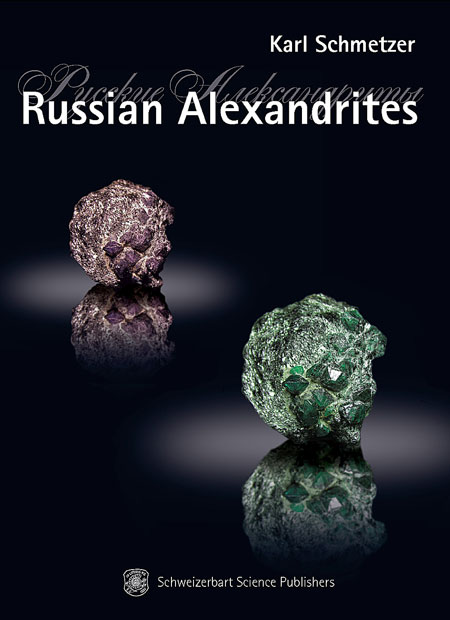 |
| On the cover. Alexandrite crystal group shown in both daylight and incandescent light; this extraordinary piece was submitted to the Gemmological Laboratory, Liechtenstein for examination in 2009. The sample measures about 8 x 9 cm. (Photo: Th. Hainschwang.) |
This volume aims to be a handy reference as much as it aims and succeeds at being a meticulously detailed and comprehensive work on Russian alexandrite: the Appendices and Timetable feature tables on primary mining localities, physical data on alexandrite and green chrysoberyls, English-German transcription of significant names and milestone events. The achievement of this book is not only its exhaustive treatment of the subject, unprecedented for the scope and detail presented, but also its historicity. It is a fascinating chronicle of alexandrite’s Russian origin and labyrinthine odyssey through time—a painstakingly researched story replete with intrigue, tragedy and epochal sweep worthy of translation to motion pictures. Such a rare and special gemstone deserves no less than the able and thorough treatment it receives in this book.
Lisbet Thoresen is an independent scholar specializing in gemological and archaeometric studies on gems of the ancient world. Previously, she was Associate Conservator of Antiquities at the J. Paul Getty Museum, where she worked on all aspects of the preservation, analysis, authentication, and conservation of the collection, including glyptic art (carved gems). She is volume editor and principal author for the book (forthcoming), On Gemstones: Gemological and Analytical Studies of Ancient Intaglios and Cameos.
[back to top]
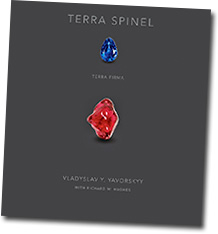 |
Note that you can save shipping charges on this book by visiting booths at the Hong Kong and Baselworld shows in March. They’re listed at the bottom of the SpinelBook.com home page.
As this month’s featured stone demonstrates, Pala International has long appreciated the beauty of fine spinels. The Palagems.com catalog contains 220 stones, in a variety of hues: blue, purple, gray, orange, brown, pink, red—even an inky green.
Last August we featured a rare 11.18-carat red spinel from Burma, cut from its original 15.81 carats. A few months earlier we were enchanted by a rich and rosy 22.76-carat spinel from Tajikistan, with some intriguing inclusions. In 2007, we offered a variety with “the base hue of a fine amethyst, the slight color shift of a sapphire, and the diagnostic dispersion.” We then quoted from Gübelin & Koivula: “In many respects, spinel is an ideal gemstone.”
 |
| Compatriot. From the same land as our featured stone—but available. (Photo: Mia Dixon) |
Strange then, how award-winning gemologist and author Richard W. Hughes, in his announcement of a new monograph on the stone, would remark, “And yet few know its name and fewer still understand its importance. This is truly a tragedy….” We now can put all of that in the past tense.
Terra Spinel – Terra Firma is a new book by Bangkok-based dealer Vladyslav Y. Yavorskyy, with the aforementioned Richard Hughes. Our personal copy, we’re told by Mr. Hughes is on a slow boat from China—literally—as he now resides in Hong Kong. The contents have nonetheless been sampled in tempting helpings at SpinelBook.com. When we spoke with Hughes prior to his announcement he was quite enthusiastic about the book’s quality: 200 hardbound pages of six-color process printing, with spot varnish giving the gemstones a special sparkle. But then, many of you already have sprung for a copy in the big tent at Tucson’s GJX Show, booth 404, 504.
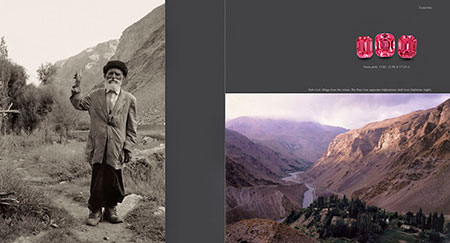 |
| Two pages from the Terra Spinel chapter on Tajikistan, including the neon-pink variety, similar to that which we featured last March. (Image courtesy Vladyslav Yavorskyy) |
[back to top]
— End February Newsletter • Published 2/16/11 —
Happy New Year to our readers, contributors, and clients!
We begin the year by remembering the late Dr. Kurt Nassau, upon whose foundation so many gemologists (and others) build. We look toward Tucson next month and back at Chicago last fall. Our featured stone hails from California and our featured book from Qatar (sort of…). Research takes us around the world, and La Niña takes us from shore to shore to shore.
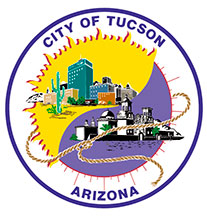 |
The tragic and heroic events of Saturday, January 8, have put a different sort of spotlight on Tucson, home of the world’s greatest gem and mineral show. With last Tuesday’s memorial, the nation—in a virtual way—came together with the people of Tucson to express condolences. Next month, the gemstone and mineral community will have a timely opportunity to do the same—in person…
See the links below on Palagems.com for Pala International’s location at the following Tucson venues, and for other show details.
One-stop general information about individual shows can be obtained from the Tucson EZ-Guide.
Scottish gemologist Alan Hodgkinson and outgoing Gems & Gemology editor Alice Keller will be honored at AGTA’s 30th Anniversary event, February 1, 6:00 p.m., at the Tucson Convention Center. Hodgkinson will be awarded an Honorary Membership and Keller will be recognized for her many years of service.
The anniversary celebration is being sponsored by the City of Tucson and will be located in the new East Entrance of the Tucson Convention Center on the opening day of the GemFair. All registered GemFair attendees are invited to attend. For more information, see this January 12 press release.
In keeping with its theme, “Minerals of California,” the 2011 Tucson Gem and Mineral Show will feature Bill Larson speaking on the topic of California tourmalines.
Speaker: Bill Larson
Presentation Title: “Fabulous Treasures from San Diego Gem Mines”
What: 57th Annual Tucson Gem and Mineral Show
When: Saturday, February 12, 2011, 2:00–3:00 p.m.
Where: Tucson Convention Center
Room: Turquoise Ballroom (TB)
We look forward to seeing our many friends there. Visit the Pala International Show Schedule for future events. [back to top]
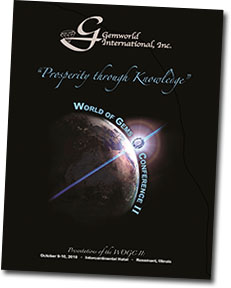 |
Proceedings of last October’s World of Gems Conference II are now available for purchase.
The post-conference booklet contains abstracts of the research presented by sixteen experts, accompanied by a liberal helping of images. A January 5 press release from conference organizer Gemworld International, Inc., describes some of the highlights.
Conference speakers covered an extensive range of topics including tracing developments in gemstone enhancement over thousands of years in the History of Gem Treatments and Nomenclature, to lessons in the fundamentals of diffusion in Of Beryllium and Beef Steak: Understanding Diffusion in Gemstones. Diamond source and identification research topics were addressed in the sessions: Treated Diamonds and Lab Grown Diamonds and a lively panel of industry personalities debated Diamond Fluorescence—Controversy and Commerce.
The release continues…
Presenters representing the GIA, AGL, Gubelin, and AGS as well as notable industry professionals including Dr. John Emmett of Crystal Chemistry, provide a wealth of gemological information. These illustrated abstracts contain the heart of each presentation from: Applying the Scientific Procedures to Lab Reports to Current World Sapphire Source; Inclusions and What They Reveal about the Stone; Selling the Legal Way to Pearls Varieties and Identification. Warranties and Lab Reports presented by an attorney specializing in jewelry industry issues discusses the guarantee you might be making by handing your customer a third party lab report.
This post conference book is an important addition to the reference library of today’s professional appraiser, gemologist and retailer.
Ordering information and a full list of conference topics is available at the conference website. Conference I (2008) proceedings also are available. [back to top]
Staying in suit with the theme of this year’s Tucson Gem and Mineral Show, we are featuring the state gemstone of California.
A monster in terms of the benitoite species, this 4.22-carat gem exhibits not only great size but also intense purplish blue color. This mixed cushion-cut jewel also throws out a little dispersion and shows some color banding seen as purple, blue, and white patches in the gem photo. This banding is also seen in the benitoite crystals with a purplish blue outer rim and a white center.
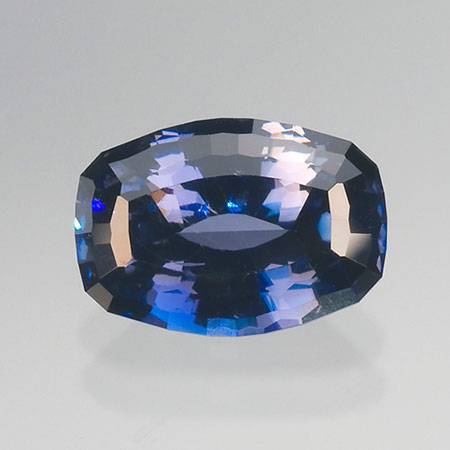 |
| Benitoite Gem, 4.22 carats, 11.77 x 8.27 x 5.0 mm. Inventory #18852. (Photo: Jason Stephenson) |
As you’re probably aware, large crystals and fine faceted benitoites are really only found in San Benito County in Central California. The story goes that a couple of copper prospectors serendipitously spotted the shiny blue gems on a weathered-out hillside one morning in 1907. Further investigations and several mining projects later, benitoite was unearthed and poised as California’s state gem.
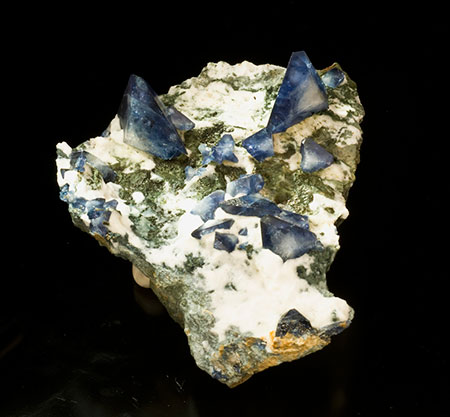 |
| Benitoite specimen: two large ditrigonal dipyramidal crystals (2.5 cm.) and several smaller ones on white natrolite and green serpentine matrix. Click to enlarge. (Photo: Jason Stephenson) |
Interested? Select the inventory number above, call, or email us to inquire.
See also these benitoite resources:
[back to top]
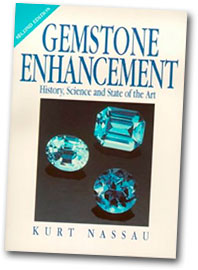 |
Kurt Nassau, Ph.D., author of eight books, including two editions of the classic Gemstone Enhancement, died in Lebanon, New Jersey, on December 18. According to a newspaper obituary, Dr. Nassau published over 450 articles and held 17 patents.
Early in his career, he joined Bell Laboratories, where his years of crystallographic research led to the publication of a brief monograph, Growing Synthetic Crystals (published by Bell in 1964), and 1980’s Gems Made by Man. Gemologists still refer to his Gemstone Enhancement, published in 1984 and 1994 editions.
Dr. Nassau’s investigations into the physics and chemistry of color resulted in four books as well as the primary contribution to the Encyclopaedia Britannica entry on color. Cornell University’s Elise Skalwold, who contributes to our newsletter this month, told us, “In our own work, Dr. William Bassett and I very frequently refer to Dr. Nassau’s text The Physics and Chemistry of Color and I often steer interested people to that wonderful book or the short version published in American Mineralogist.”
In his email-exclusive newsletter, Gary Roskin recounted personal memories of Dr. Nassau.
While it had been a few years since we had last been in contact with Kurt, no matter what he was doing, he always made time for the gemologist/reporter’s question regarding treatments and synthetics. However, getting a straight answer from him wasn’t always that easy. Being the consummate teacher, one had to go through a series of short quizzes in order to have the question answered. Getting the right answers to those little quizzes wasn’t the point of his testing. Nassau just wanted us to learn, and more importantly, understand the science behind the gemological tests.
Pala International’s Bill Larson recalled, “Kurt was a very good friend to Pala. Whenever we needed treatment information he would help or steer us in the right direction.”
A comprehensive obituary was published by the Gemological Institute of America in its G&G eBrief, for subscribers, which later will be archived here. [back to top]
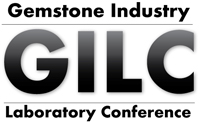 |
The contentious issue of Tibetan andesine (see our Nov. “Andesine Angles”) will be the topic of discussion at the International Colored Gemstone Association (ICA)-sponsored Gemstone Industry Laboratory Conference (GILC). Speaking to agenda item #1, “Andesine Update,” will be Dr. Ahmadjan Abduriyim of the Gemological Association of All Japan, who will moderate a panel that will include “Richard Hughes and representatives from the Gemological Institute of America [GIA] who will confirm both the field trip as well as laboratory analysis of the material recollected during this last mission,” according to an ICA announcement dated December 10 on its nicely revamped website. “Dr. Adolf Peretti of GemResearch Swisslab will present a video and a general conclusion of the andesine issue based on visits to the field and research of new material.”
An October report co-authored by Dr. Peretti contained a reference to “a very elaborate hoax,” which was seized upon by another Tucson 2011 presenter, Robert James (International School of Gemology), who surely will touch upon the subject in his “Forensic Gemology and the New Generation of Treatments” at the Tucson Gem and Mineral Show (TGMS).
For the record, the colorful “hoax” remark was made by Shane McClure of GIA Laboratory, Carlsbad, in a September 2009 report; it was not a statement, but rather a question—a question that, when taken in its context, would seem to contradict the very point being made by its inclusion in the Conclusion of the October report. We’re sure this point will be clarified at GILC. You’ll want to do your homework ahead of these sessions, beginning with McClure’s report…
…continuing with the Fall/Winter issue of ICA’s InColor, which briefly covers the mining visits of Dr. Abduriyim et al. to Tibet (you’ll extend your stay there for major reports on “Ethical Mining and Fair Trade” and “Focus on Brazil”)…
…and including a letter prepared by China for the GILC discussion. Yes, the government’s National Gemstone Testing Center sent its own team to yet more apparently-salted andesine fields last spring. But don’t look for it on the lab’s website; the English-language section hasn’t been updated since 2006. The team’s report is being issued in Letters to the Editors of the forthcoming edition of Gems & Jewellery, published by Gem-A, The Gemmological Association of Great Britain.
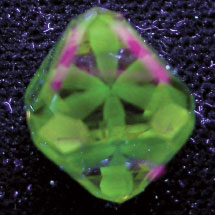 |
| Flower cloud. Faint green-yellow fluorescence is emitted under longwave ultraviolet illumination in this 7.39-carat diamond. Other areas in the stone are inert. (Photo: Dr. Eric Erel, courtesy Rapaport Diamond Report; stone courtesy Great Diam) |
Carat Gem Lab: Last month we looked at an unusual “insect” inclusion in diamond, and we touched on fluorescence in October. Dr. Eric Erel of Carat Gem Lab brings both together in his overview of diamond inclusions, “Inclusions Explained,” published last March in Rapaport Diamond Report.
In his 2009 “Clarity Treatments for Diamonds,” published in The Journal of the Gemmological Association of Hong Kong, Dr. Erel includes a photomicrograph of another vaguely insect-shaped internal fracture (Fig. 2), which was treated by a drill-hole method for dissolution of undesirable internal features.
GIT-GTL: “Unusual Cultured Pearls” was issued by The Gem and Jewelry Institute of Thailand Gem Testing Laboratory (GIT-GTL) and actually concerns three Australian baroque pearls that were purported to be natural. X-radiography of the three revealed both radial and void structures that may be found in natural and non-beaded cultured pearls, respectively.
Gemstone Information Manual: Earlier this month, the tenth edition was issued of this “industry information guide for natural gemstones, enhanced natural gemstones, and man-made stones.” According to a January 7 notice to its members, ICA has agreed to adopt the disclosure codes outlined in the manual, which previously had been used by AGTA and CIBJO, the World Jewellery Confederation. Access a PDF of the manual here.
SSEF: Traveling with time on your hands for a hands-on experience? Swiss Gemmological Institute (SSEF) has launched an iPhone app (pictured below) that provides the six closest gemstone-producing areas for a given location. The application, GemExplorer, “also provides a search function based on different gemstone categories,” according to a January 12 press release. The app is free from iTunes.
We’ve been informed that SSEF’s annual Facette e-journal (No. 18) will be published about this time next month.
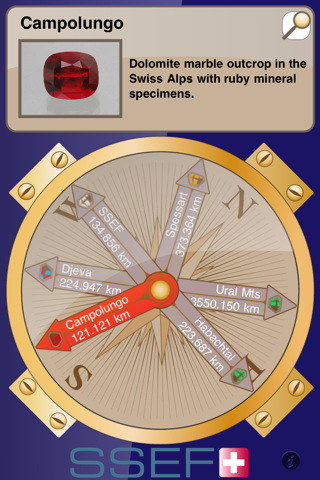 |
Gems & Gemology: And speaking of smartphones, Gems & Gemology published an item on December 17 about an inexpensive microscope accessory (less than $20) that attaches to the phone and “offers varying levels of magnification, and illumination is provided by two white LEDs.” [back to top]
When you visit the website of the Blue Hollow Mine in Australia’s Queensland, Peter and Debbie Chalmers greet you with the reassuring, “We have recovered from the flood and are open for business.” Scroll down, however, and you’ll see a link to photos from flooding in January 2008, during the last La Niña phenomenon (a dropping of surface temperature in equatorial eastern central Pacific Ocean that can cause meteorological mayhem).
In early December, the Gemfields area of central Queensland experienced heavy rainfall—between 4 and 8 inches in a single overnight drencher, causing roads to be closed and flooding of homes. The towns of Sapphire and Rubyvale were cut off. Rains appear to have abated—only three quarters of an inch was predicted for each of Monday and Tuesday.
When we queried Francine Payette, chair of The Australian Gemmologist, she told us that the country’s opal miners have not been affected.
But I have to admit that at the time being I am more worried about the well being of my friends and colleagues of the [Gemmological Association of Australia] (close to 250 members live in Qld) than about flooded mines. The Government of Queensland declared that 75% of the State is considered a “disaster zone”.
She asked us to urge our readers to donate to the Queensland Government’s flood relief appeal. (The government cautions consumers about illegitimate charities, and provides a link to SCAMwatch.)
The El Niño/La Niña phenomena were “originally recognized by fisherman off the coast of South America,” according to the National Oceanic and Atmospheric Administration. So it’s perhaps not surprising that Brazil, on the other side of the continent, was hit with flooding rain in the state of Minas Gerais. Gemstone mining areas in the northeast of the state appear to have been spared by the weather. But the southern part of the state, as early as January 7, had lost 16 people, with 14,400 made homeless, according to BBC.
 |
| Mau horizonte. Last weekend, the governor Antonio Anastasia flew over the cities hit by the rains in southern Minas. The governor urged donations to be made to Red Cross in Belo Horizonte. (31) 3224-2987 or see info in Portuguese and English. (Photo: Peter Wellington/Imprensa MG) |
Also spared from flooding, at least as reported, are some of Sri Lanka’s gemlands, while much of the country has been inundated, according to Saturday’s Daily Mirror. More than 1 million people have been displaced. With cruel irony, the mines that have been affected are the explosive type—a legacy of civil war—which floodwaters unearth. The United Nations will be issuing an appeal in the coming days for those affected by the flooding. The Daily Mirror reported a month ago that two gem miners were killed and five others injured (including the owner) when a mine collapsed at Puhulwella in the southern district of Kirinda. [back to top]
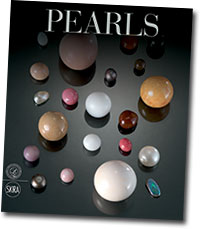 |
This month, Elise A. Skalwold, FGA, GG, of Cornell University looks between the covers of an important book published last fall following an exhibition of some of the world’s rarest pearls. Elise then recounts curating a more modest but “diverse collection of odd little pearls.”
Recently, the body of gemological literature has been vastly enriched by the addition of what can only be described as a sumptuous and lovingly produced book entitled simply Pearls. Written by Hubert Bari (author of Pink Pearl: A Natural Treasure of the Caribbean) and David Lam, Pearls was published to coincide with the exhibition by the same name, held from January to June 2010 at the Museum of Islamic Art in Doha, Qatar. Both the book and exhibition were financed by the Qatar Museums Authority (QMA), chaired by Her Excellence Al-Mayassa bint Hamad bin Khalifa Al-Thani. The holdings of Qatar comprise possibly the most extensive assemblage of natural pearls in the world, as well as historical documents, jewelry, and relics of a once vibrant pearl-fishing culture. Through the exhibition and book, the authors and the QMA bring to the wider world this amazing treasure of nature, culture, science, and beauty.
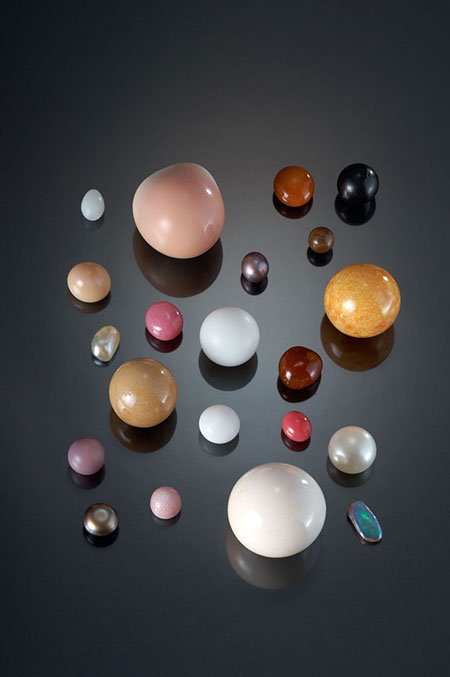 |
| Pearl Salad. Natural pearl treasures from the Qatar Museums Authority in Doha, Qatar. Measuring 28.73 mm. and 111.5 carats, the rarest of all is the large salmon-colored pearl at the top; the only known pearl of the emperor helmet (Cassis madagascariensis) from Florida. (Photo: Christian Creutz, courtesy of Hubert Bari and David Lam. See key below). |
Pearls is destined to become a classic tome on the subject of natural pearls and makes a very fine companion to Elisabeth Strack’s comprehensive text Pearls (Perlen), scientific journal papers, as well as historical texts such as The Book of The Pearl by Kunz and Stevenson. Written in an accessible style for the layman, it draws on the expertise of not only its authors, but also the leading-lights of pearl research. The authors and QMA acknowledge an impressive list of such people and institutions, while the book reflects this in the depth of knowledge conveyed by its text and imagery.
In fact, it is the imagery which first attracts and singles this book out. As one’s fingers graze its smooth pages, the sensuous portraits seem almost holographic, tempting the reader to gather the pearls off its leaves. The breathtaking portraits by Christian Creutz, Jeff Scovil, and others, along with images both historical and contemporary, make this as much an art book as a reference text. Readers will see (for the first time in many cases) natural pearls of extreme rarity alongside the molluscs which birthed them; not only oysters and mussels, but also nautilus, conch, volute, murex, clam, and many others. Photomicrographs by John Koivula and scanning electron microscope (SEM) images and pearl sections provided by Dr. Henry Hänni help the authors unravel the mystery of these pearls’ unique optical properties and genesis.
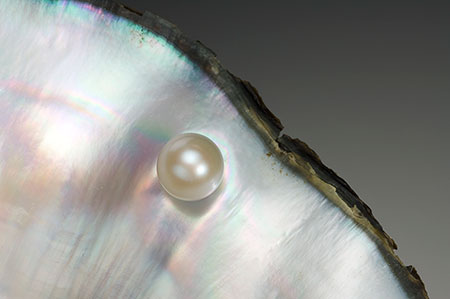 |
| Within the original washboard mussel in which it was found, a perfect American freshwater natural pearl lies nestled in its nacreous bed. Megalonaias nervosa, 2.04 carats and 7 mm. (Latendresse Collection; photo Jeff Scovil; from the book Pearls by Hubert Bari and David Lam) |
The 336-page book is broken into seven sections: “The Nature and Formation of the Pearl”; “Pearl Molluscs”; “The Pearl, a History of Indifference and Passion”; “The time of the Great Fisheries (1850–1940)”; “The Culture of Pearls”; “Gentlemen-Farmers”; and lastly, “Chanel and Pearls.” The last four sections provide a cultural and historical context for these small wonders, with intriguing insights and fascinating images drawn from antiquity to the present. For the present writer (EAS), the over 100 pages comprising the first two chapters are the most precious for they are the ones which, with 120 photographs, provide a fantastic view into the world of natural pearls of every variety.
Pearl aficionados, gemological bibliophiles, natural history buffs, and humanists alike will all appreciate this book and, with its surprisingly reasonable pricetag for a hardcover book of its quality, this gem is an easy choice.
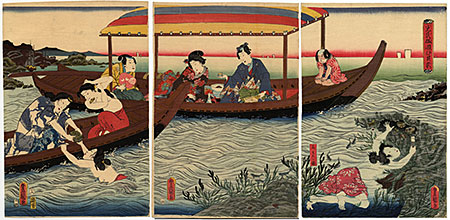 |
| Women dive in search of abalone while their prince watches with anticipation in this 1958 triptych by Utagawa Kunisada. (Private collection; Photo: Christian Creutz; courtesy of Skira) |
As the timely appearance of the Bari and Lam book might suggest, there is a renewed and growing interest around the world in natural pearls. Historically pearls have been coveted by many cultures and in many time periods, especially those from the familiar oyster. Today, connoisseur pearl collectors (a rarified community in itself) seek out the rarest examples and those which exemplify the type.
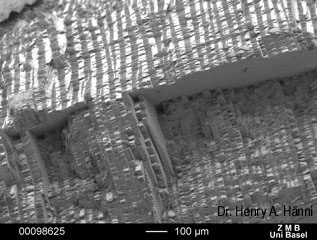 |
| Above, Dr. Henry Hänni reveals the intricate structure of lath-like aragonite crystals responsible for melo pearl’s characteristic flame structures (SEM image courtesy of Dr. Hänni). Below, the “pearl” in the back is actually a clever fake; read more. (Photo: Elise Skalwold) |
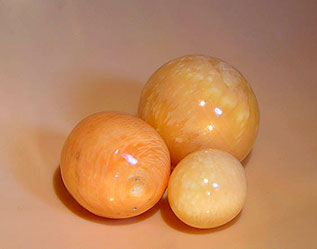 |
But who defines the type and where does one turn to learn about these highly unusual objects—each one unique even within its own species? These were questions we at Cornell University were faced with more than a year ago when curating a small but diverse collection of odd little pearls, some hardly recognizable as such, so little did they resemble the classic variety!
As we studied them, their phenomenal optical properties and physical structures started to reveal themselves and our fascination grew, both with the pearls themselves and the potential relevance to an educational environment. Reaching out to the original owners of these pearls (K.C. Bell and others) provided insights into the provenance, while a literature search led down many paths…many ending with the usual suspects: the research of Ken Scarratt, Henry Hänni, Emmanuel Fritsch, Stephen Karampelas, Elisabeth Strack, Nicholas Sturman, and Antoinette Matlins—to name just a few which readers might recognize—but also to researchers in the world of bio-mineralization whose work may be more obscure to the casual reader (see this bibliography).
We first turned to Professor Dr. Hänni of the Swiss Gemmological Institute (SSEF), who has spent a lifetime teaching and researching in the field of gemology. Dr. Hänni’s special love of pearls (and maw-sit-sit, but that is another story), has led to a wealth of scientific papers, the latest of which is to be found in the most recent issue of the Australian Gemmologist, “Explaining the flame structure of non-nacreous pearls” which discusses that most coveted feature of conch and melo pearls: the chatoyant-like flame structure. Our interest in the polymorphs aragonite and calcite (which produce the optical effects seen in pearls of many types) was piqued by his discussions via email of their properties and the SEM images he shared with us.
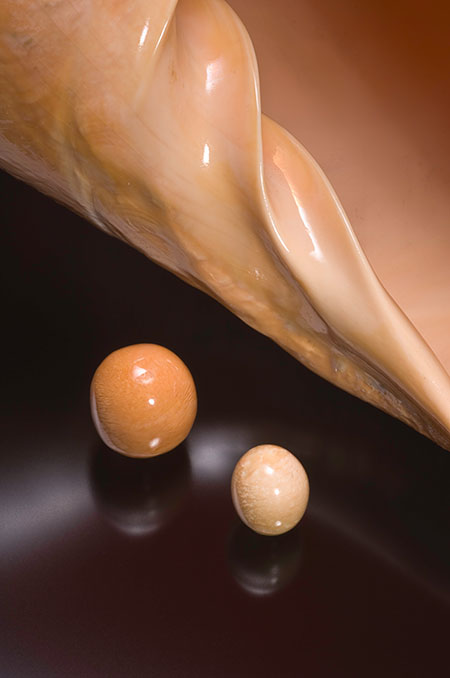 |
| Melo pearls with Melo melo shell. Visible is the whorl of the shell from which the pearl simulant shown in this image may have been carved. (Cornell University Collection; Photo: Jeff Scovil) |
Perhaps even lesser known than the pink pearl produced by the queen conch, melo pearls turned out to be a unique study specimen for us. While one of the best books on this subject is the 1999 The Pearl and the Dragon: A Study of Vietnamese Pearls and a History of the Oriental Pearl Trade, a wonderful and easily accessible resource is to be found on the Pala website: “Melo Pearls from Myanmar,” summarizing the 2006 International Gemological Symposium poster presentation of the same title. More questions arose and more opportunities soon presented themselves. K.C. Bell offered for study a fascinating melo pearl simulant pictured above to which we could compare the real melo pearls with the properties of the shell. Continued guidance from Dr. Hänni, along with online conversation with GIA Bangkok’s Nick Sturman (who had recently given a Gemstone Gatherings presentation on melos) make us optimistic that we will be able to make our own SEM images this spring and further explore for ourselves these fascinating microworlds.
A final thought: sometimes the most fascinating opportunities for gemological study come from outside the gem world. In this case, out of the woods: a professional turtle hunter (featured in an old National Geographic magazine) heard I liked to study weird pearls; actually he said weird “things.” He drove several hours to bring me the treasure of a dear friend who had discovered something very special while digging for clams decades ago:
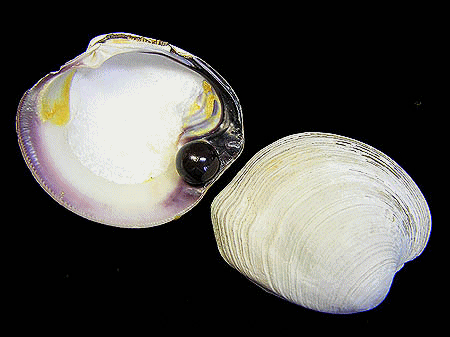 |
| Quahog pearl and shell. (Photo: Elise Skalwold) |
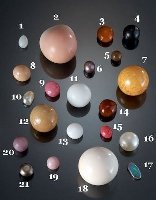 |
1. Spondylus regius (Regal Thorny Oyster); 2. Cassis madagascariensis (Helmet Shell or Emperor Helmet); 3. Pleuroploca gigantea (Florida Horse Conch); 4. Atrina vexillum (Black Pin Shell); 5. Pleuroploca trapezium (Horse Conch); 6. Pinctada mazatlanica (Panama Shell [Madreperla]); 7. Melo melo (Indian Volute); 8. Pleuroploca gigantea (Florida Horse Conch); 9. Strombus gigas (Queen Conch); 10. Pinctada radiata (Atlantic Pearl Shell); 11. Tridacna squamosa (Fluted Clam); 12. Melo broderipii (Volute); 13. Nautilus pompilius (Nautilus); 14. Pleuroploca gigantea (Florida Horse Conch); 15. Strombus gigas (Queen Conch); 16. Pinctada maxima (Silver [gold] Lip); 17. Haliotis iris (Abalone); 18. Pleuroploca gigantea (Florida Horse Conch); 19. Argopecten purpuratus (Scallop); 20. Lopha cristagalli (Cockscomb); 21. Pinctada maxima (Silver [gold] Lip). (Photo: Christian Creutz, courtesy of Hubert Bari)
As we noted in November, this year’s Accredited Gemologists Association conference at Tucson will feature two of the experts mentioned above by Elise Skalwold. Elisabeth Strack and Ken Scarratt will speak on pearl-related topics in keeping with this year’s theme, “Of Pearls and Gemstones – New Treasures & Challenges.” Four other notable presentations also will be made. See the AGA website for more information.
Pala International has several melo pearls in its inventory. See them here. [back to top]
— End January Newsletter • Published 1/18/11 —
2015.3 | 2015.2 | 2015.1
2014.3 | 2014.2 | 2014.1 | 2013.3 | 2013.2 | 2013.1 | 2012.3 | 2012.2 | 2012.1
2011.3 | 2011.2 | 2011.1 | 2010.3 | 2010.2 | 2010.1 | 2009.3 | 2009.2 | 2009.1
2008.3 | 2008.2 | 2008.1 | 2007.3 | 2007.2 | 2007.1 | 2006.3 | 2006.2 | 2006.1
2005 | 2004 | 2003 | 2002 | 2001 | 2000
Note: Palagems.com selects much of its material in the interest of fostering a stimulating discourse on the topics of gems, gemology, and the gemstone industry. Therefore the opinions expressed here are not necessarily those held by the proprietors of Palagems.com. We welcome your feedback.